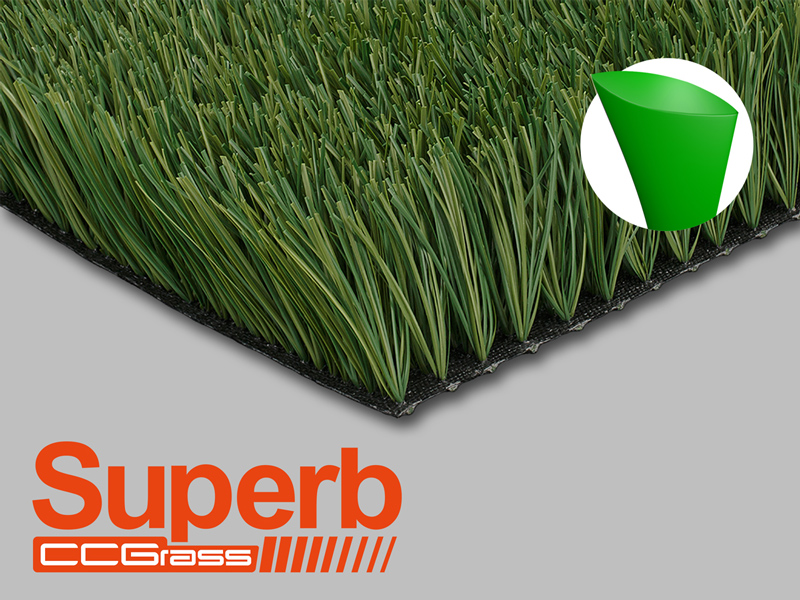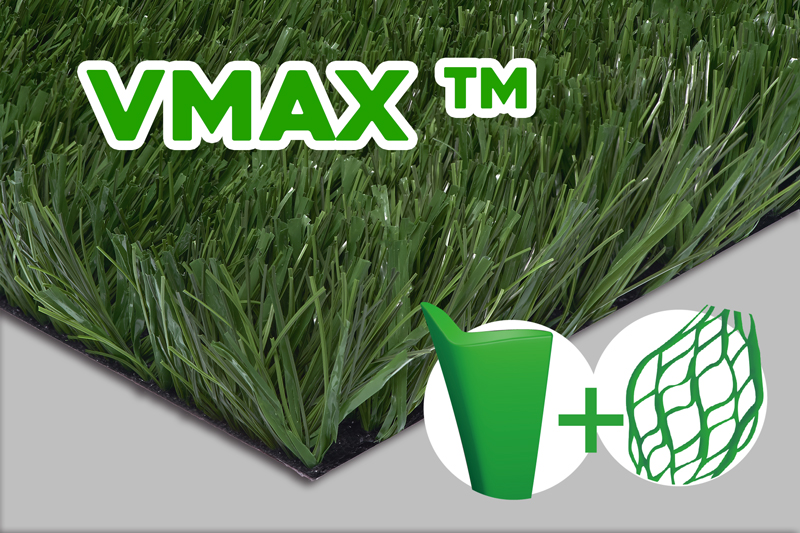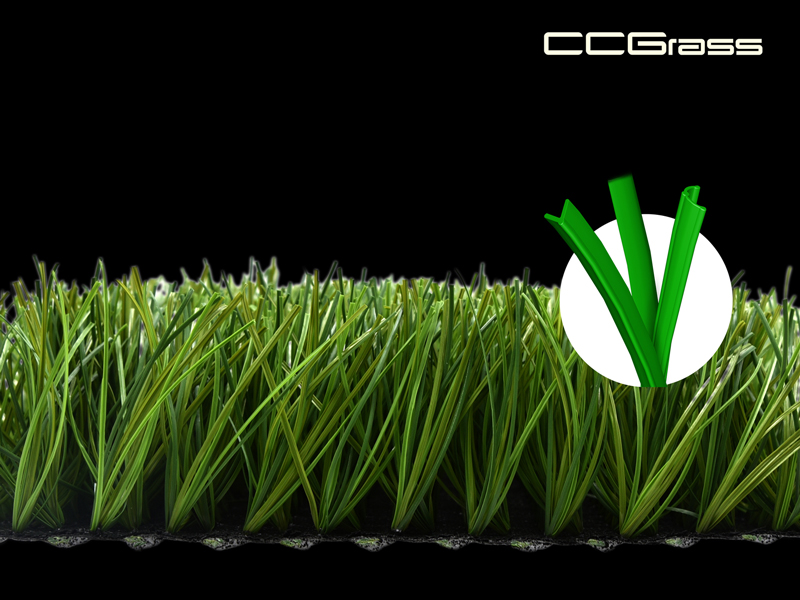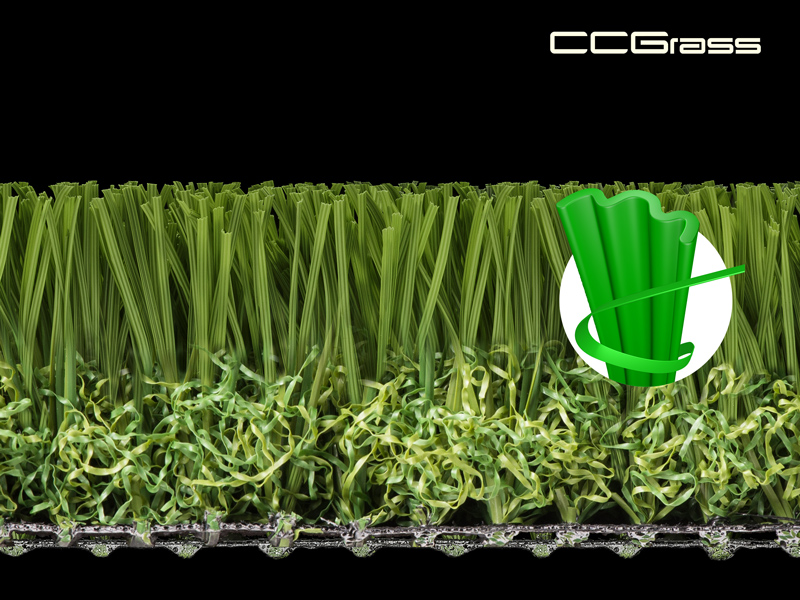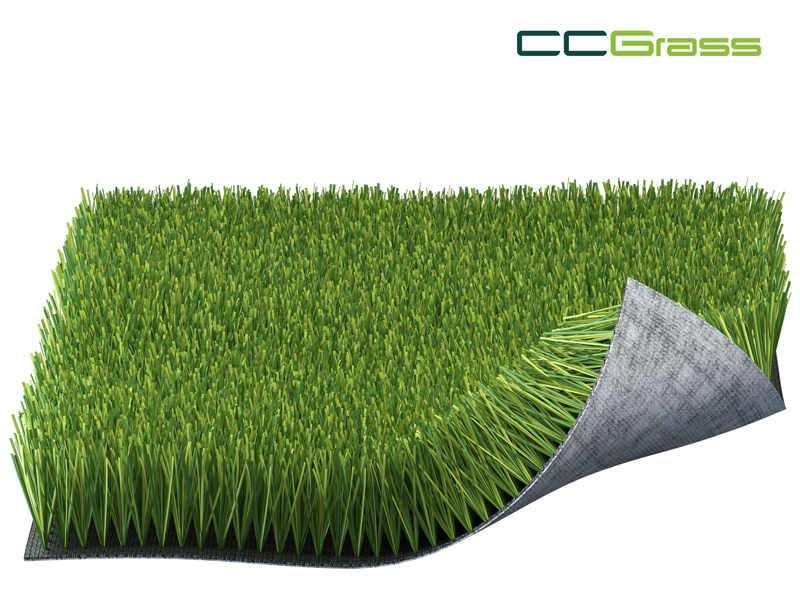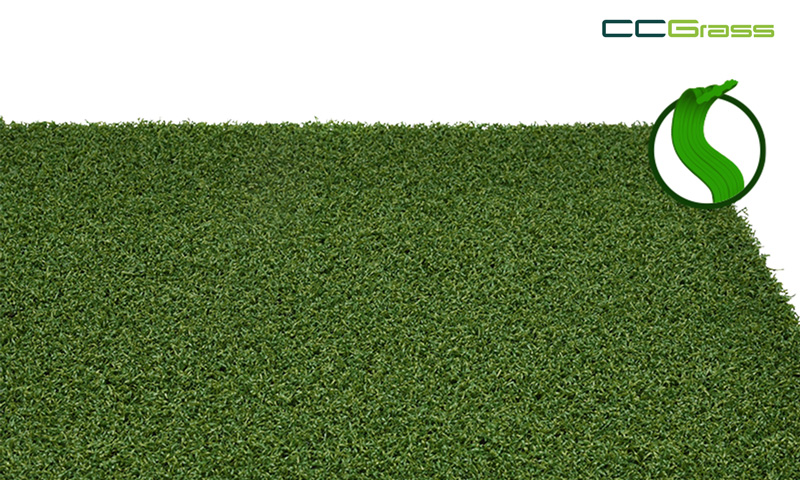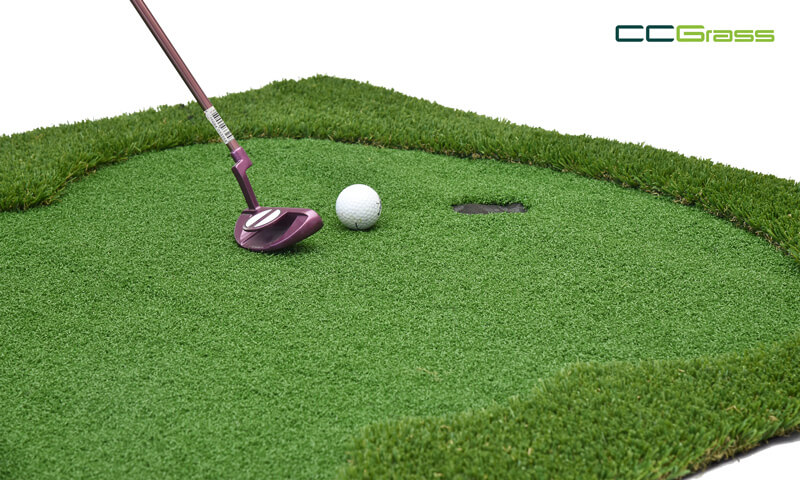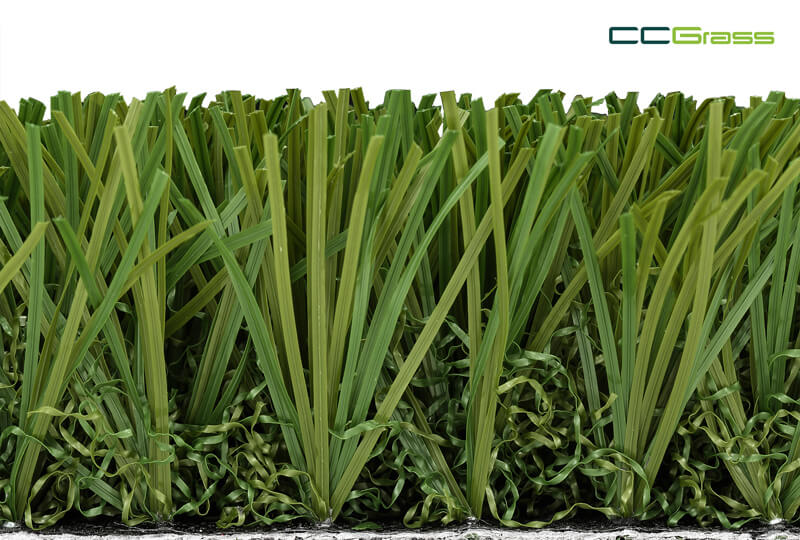Artificial grass, also known as synthetic turf, has transformed landscapes and sports surfaces worldwide with its remarkable engineering. While it may appear simple, with strands of “grass” attached to a fabric backing, its production is a fascinating mix of innovation and precision.
To understand artificial grass production, let’s take a behind-the-scenes look at CCGrass, the world’s largest manufacturer of artificial grass. Through an exclusive video tour of our manufacturing facility, explore the key stages of production, from extrusion to tufting and beyond.
In this article:
Yarn Production Process of Artificial Grass Manufacturing
The yarn, or grass fibres, used in artificial grass play a crucial role in determining the appearance, durability, and performance of the final product. The process to produce the fibre is called extrusion.
In simple terms, raw polymer pellets, colour and UV additives are mixed together, then transformed into either a tape or individual fibres. These are then twisted and wound onto spools that are then sent to the next stage of the production process.
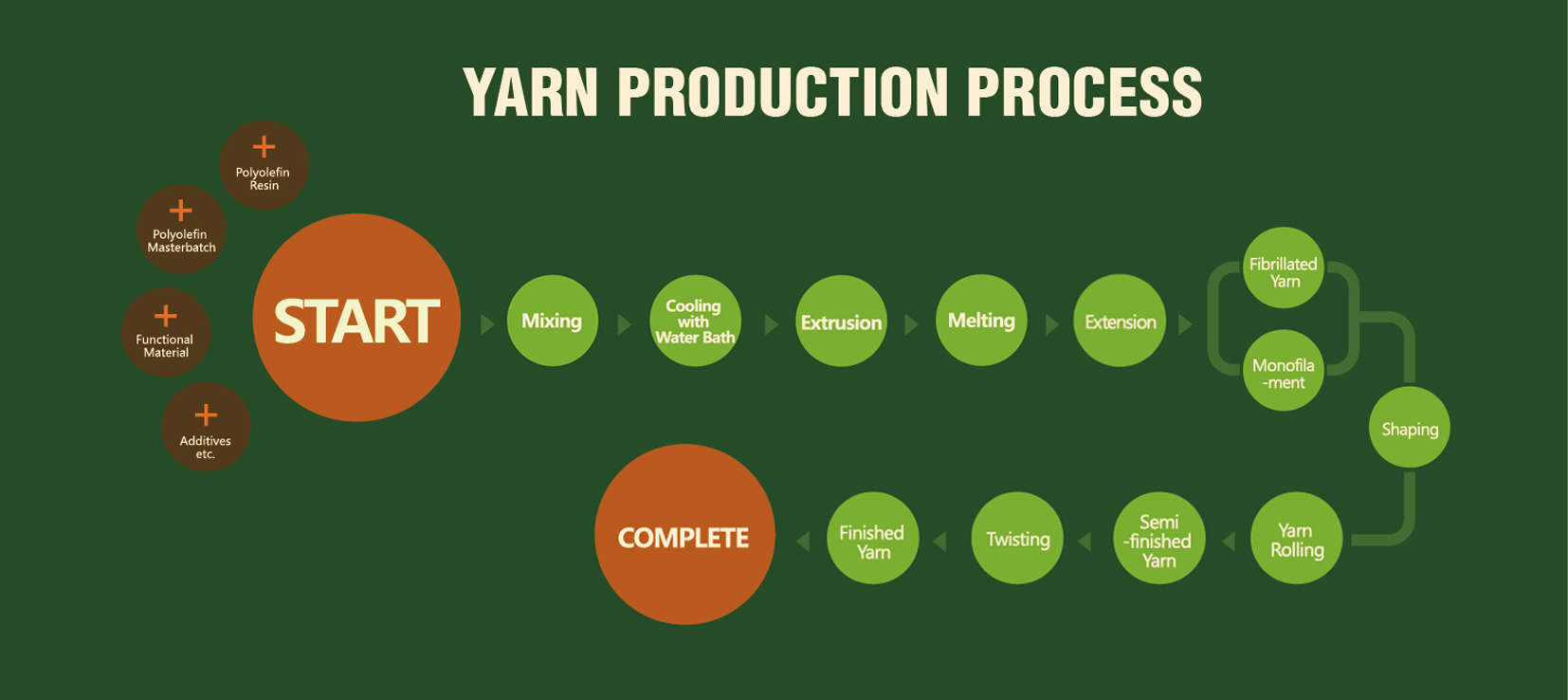
Material: What is artificial grass made of?
At first, artificial grass was made from nylon (PA), then polypropylene (PP), and now mainly polyethylene (PE). The most common polymer used is a grade known as C4, but more advanced artificial grass manufacturers use C8, a purer and stronger material.
This is more expensive but helps to produce longer-lasting yarns.
Polyethylene: Polyethylene stands out as the preferred material for artificial grass, prized for its versatility and ability to strike an ideal balance between durability, aesthetics, and softness.
Polypropylene: Often employed as a thatch layer, polypropylene enhances the realistic appearance of the turf and provides a comfortable foot feel.
Nylon: Despite being the most durable, it’s also the most expensive and has a stiff texture, making it less desirable.
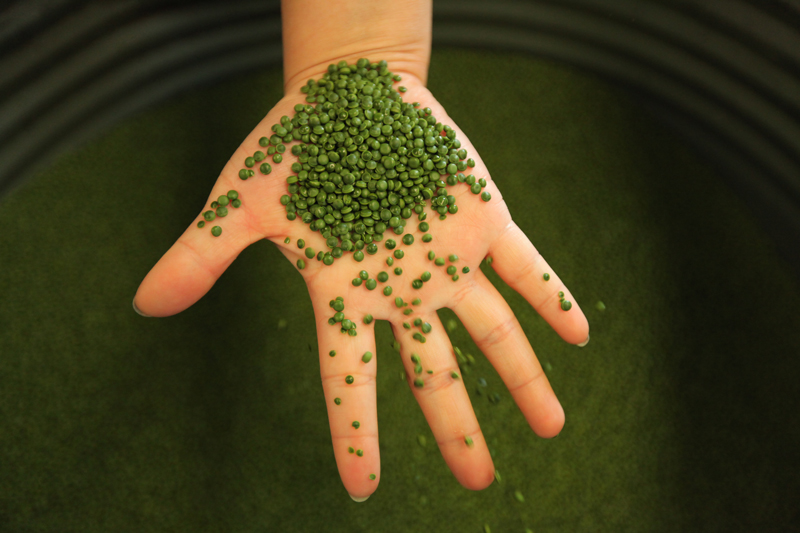
Types of artificial grass fibres
Fibrillated or monofilament
Whilst using the same raw materials, after the melting and mixing part, two different but similar production routes are followed. Fibrillated yarn is created as a tape, which has a perforation pattern added, that allows fibres to open up on tufting, to create a grass-like appearance. Below we focus on monofilament yarn.
Monofilament shape
With monofilament yarn, it is possible to create different shapes. This allows for creativity in design, with some shapes, such as diamonds, proving more resilient and stronger than flatter yarns. Our star product Superb, whose grass yarn is diamond-shaped and uses advanced C8, is the most durable product in the market.
The still pliant, hot, mixed material is squeezed, a little like toothpaste, through a specially created dye, into individual fibres. These are then stretched and cooled, before groups are combined together, which eventually become the tufts, in the finished turf.
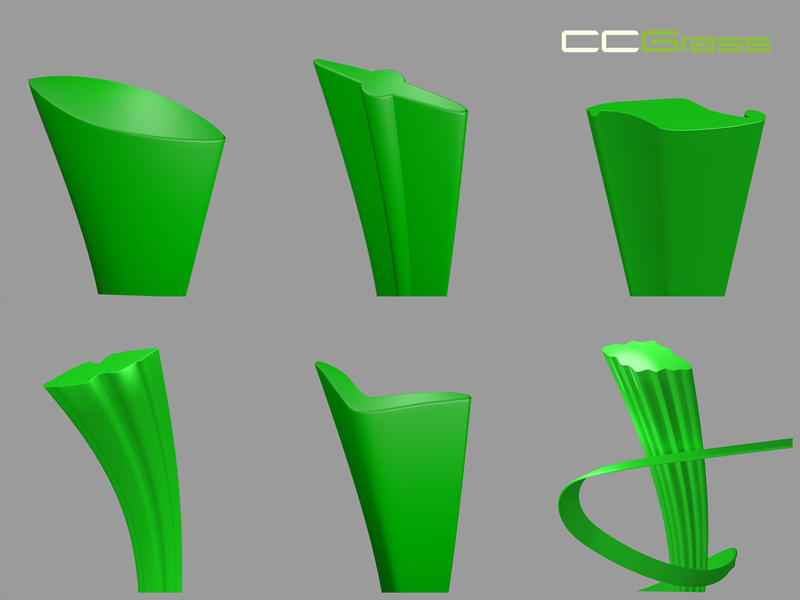
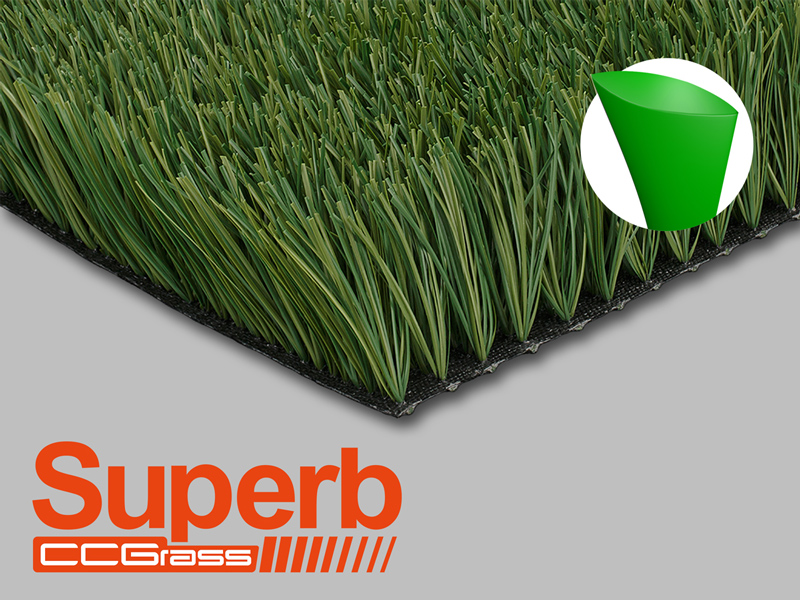
Colour
Right at the beginning of the extrusion process, the master colour batch is added. This is the point where different coloured yarns can be created. Normally, a master batch will produce a specific volume of colour, enough to make several fields. However, matching the same specific green master batch to another of the same colour does not always create a perfect match
It is possible to combine different shades of green in one tuft, to create a more natural grass appearance, with emerald, olive, lime and forest being the most common shades.
For sports like hockey, padel, and tennis, we have different coloured grass to favor the contrast of the ball in different environments. You can find them in classic green, diamond blue and so on.
Weight
Yarn weight is called Dtex and varies according to the individual yarn shapes produced. Generally, for sport, the Dtex will be 12,000, but can increase up to 17,000. Heavier than this weight means increasing the thickness and width of the individual fibres, but that can be too large for the next stage in production – tufting.
Keeping consistency in yarn weight is essential for the end product to match test results and product specifications.
Texturised yarn
When yarn is produced for hockey, a curl is added during the extrusion process. A lighter yarn is used, normally around 8,000 Dtex, twisted then heat set to create a permanent crinkle.
The curl can be added in an “in line” process, or, more commonly, a second stage is required, where the yarn is texturised on a different machine. Both ways produce consistent curls, the extent of which can be controlled during the process. “In line” is faster and more cost-effective.
In house production
Artificial grass suppliers with their own extrusion capabilities have much more freedom to design unique yarns, manage the cost better and be in full control over its own stock. “Just in time” production is also possible, with costs kept down through a much-reduced need to hold stock yarn.
Turf Production Process – Tufting of Artificial Grass Manufacturing
The process of creating the synthetic turf whereby fibre is tufted into a backing cloth, then cut to create individual tufts of artificial grass.
Understanding the tufting machine
Behind each tufter is a creel, which holds the spools of yarn produced during extrusion. The layout and techniques used in loading a creel, assist in production efficiency.
Immediately at the rear of the tufter is the backing cloth roll holder. This feeds a single sheet of backing into the tufting machine. Many companies will have two feeders, enabling different backing cloths to be combined, to assist with eventual tuft lock and carpet stability.
Two of the elements in the tufting equipment where accuracy and quality are essential are the needles that the yarn is threaded to, and the sharpness of the knives, beneath, that cut the fibre to the correct length.
Different tufting machines are used to make long or short pile turf. This is governed by the gauge, or the distance between each needle. For hockey, a 3/16 inch gauge would be used, whereas for longer pile football turf, a 3/4 or 5/8 inch gauge is used.
The wider the gauge the faster the tufting machine runs. Machines are also set to produce between a range of fibre heights, with the lowest pile heights starting at 9mm up to the wider gauge tufting machines that can reach 70mm.
The final part of the tufting set-up is the repair and check area before the tufted turf is transported onto stage 3 of the process, the backing line.
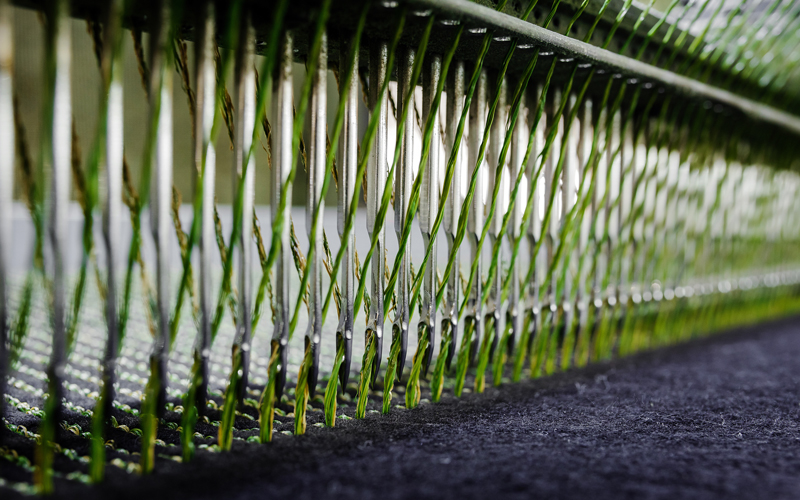
Process
Yarn is pulled from the creel, through tubes and fed into needles. These are numbered for accuracy and checking. The needles punch the yarn through the backing cloth that is slowly pulled through the tufting area. At the right length, knives cut the loop, to create the tufts and the roll moves on, at the desired speed, to set the right number of tufts per linear metre.
If a yarn breaks, the machine stops and the yarn is fixed. The repair is completed through the reverse of the turf, in the checking area, and the front is trimmed to match the length required.
The tufted turf is fed through, and ready for transport to the backing area.
Quality control
There is a good degree of skill involved in this process, but as much as that, it is attention to the small details, which produces great turf. Correct training and the right attitude from the creelers and tufting team are essential.
A standard tufting team would have a creeler, tufting operator and checker at the back end of the process. It is also expected that each stage would be regularly checked by Quality Control, who would oversee a group of tufting machines.
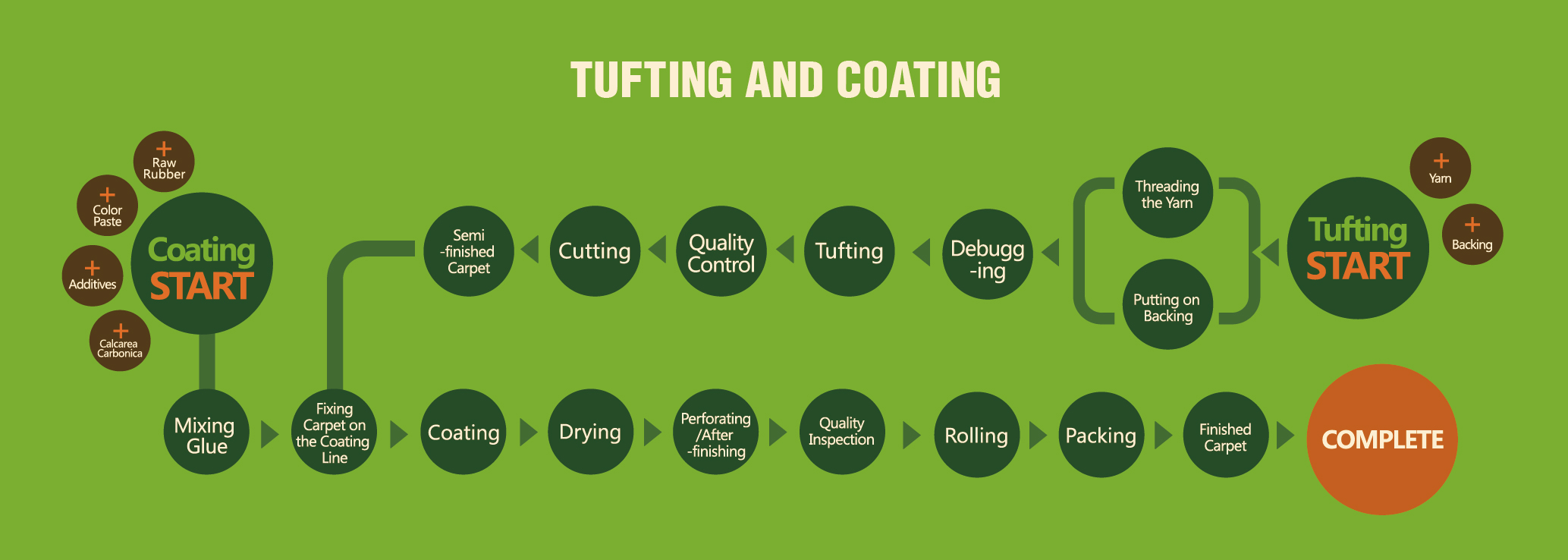
Turf Production Process – Backing of Artificial Grass Manufacturing
This process ensures that the fibres are secured to create the finished synthetic turf, thereby completing the artificial grass manufacturing process.
Types of secondary backing
The synthetic grass fibres have already been tufted into a primary backing cloth or cloths, which are loosely holding the fibres in place. The tufted rolls are transported to the backing line ready for the next stage in the process. There are two types of secondary backing that are now applied: latex or polyurethane (PU).
Equipment
A modern backing line consists of different components each playing a key role in the production of the finished turf. Most backing lines are at least 30m in length and some extend over twice this length.
This depends on the sizes of the ovens used to dry the back of the turf. These ovens are controlled for heat, as a mistake in the temperature can mean the backing does not dry correctly or could mean over-cooking.
Essential to any backing line is an area where final quality checks can take place.
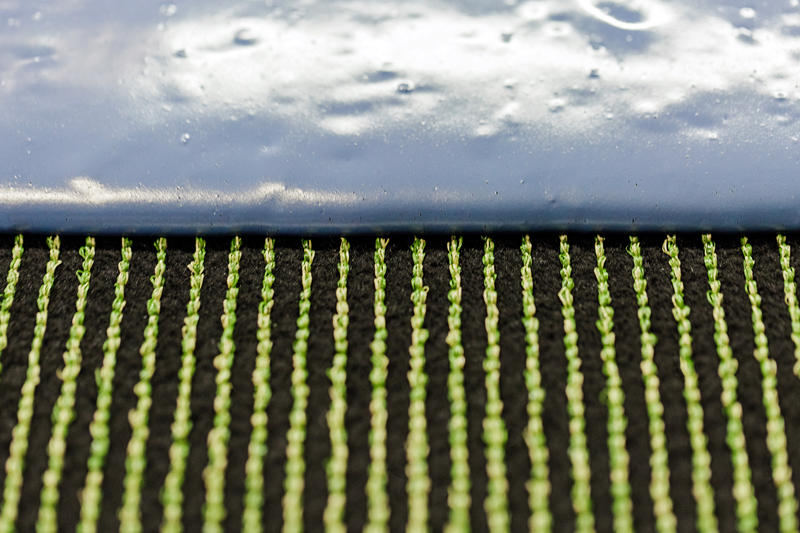
Process
The process starts with the unbacked turf being pulled, fibre downwards onto a flat surface where the secondary backing material is applied to the primary backing. There are different ways to achieve the same result, which ensures a full covering of the back of the tufted turf.
The turf is then pulled through a series of ovens where heat is applied to the back, to dry out the secondary backing. Some controlled heat is allowed to the fibre side of the turf, which allows the individual fibres to open up.
Drainage
As the, now-backed, turf leaves the ovens it passes into an area where drainage holes are punched through the turf, at an equal distance, to ensure future, rapid drainage. From here the turf is suspended into collecting bins, ready for final inspection.
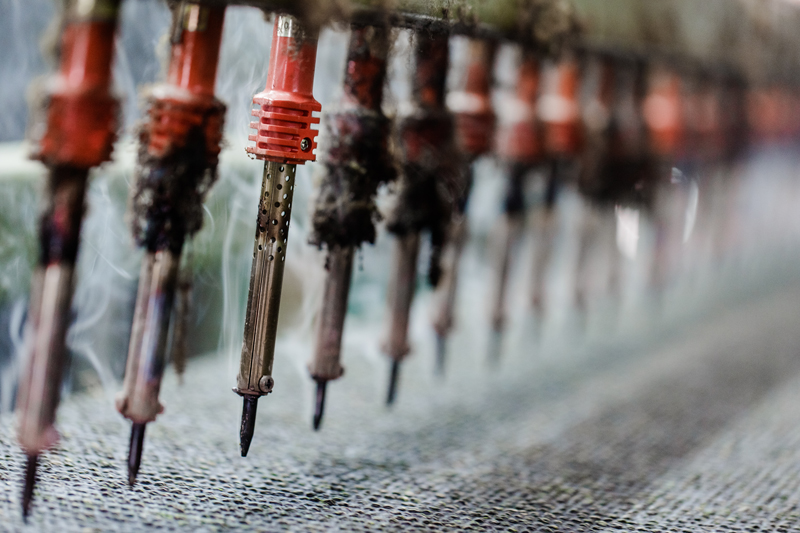
Final checks
Throughout the process there are quality checks. These include checking the consistency, application and weight of the latex or PU material that is used, monitoring the temperature of the ovens, checking the backing has dried and drainage holes are correctly applied.
Final checks are essential to the finished quality and involve visual inspection and specific product tests.
Each roll is monitored as it comes through an inspection area, immediately before it is rolled up and wrapped for delivery. Here checks are made on the strength of the tuft lock, the length of the fibre, density of stitches and other quality control measurements. These are recorded in the event of a future issue.
Under artificial light it is not always possible to pick up flaws in the turf, although the inspection area is as well-lit as possible. Occasionally spot checks will include taking a complete roll outside, unrolling under natural light, and checking for product consistency, colour differences and line straightness.
Having confirmed the quality of the produced turf, the manufacturing side is complete. Next, we will look at the importance of the roll-up unit, preparation for delivery and final dispatch.
After Production – Wrapping, Packing, Shipping and Unloading
Having made great synthetic turf, it is important it arrives at its final destination in perfect condition.
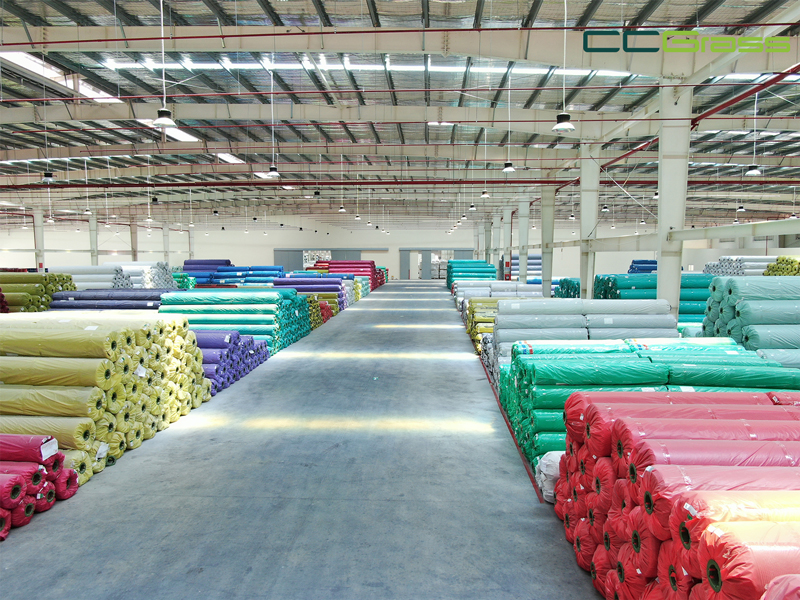
Wrapping
Once turf is backed and checked it is rolled up tightly, ready for dispatch. This may sound simple, but if not performed correctly can lead to a variety of problems on site.
These range from rolls becoming loose during transport, and subsequently very hard to unroll, or creases forming within the turf. To prevent issues, the roll-up unit pulls the turf tight as it is fed through, before it is cut to the required length.
The rolls are wrapped in plastic covering, secured at each end, to prevent water seeping in when on site. Each roll is numbered and will correspond with a location on the layout plan.
Packing
Rolls are placed into the transport container, by long booms on heavyweight forklift trucks, either onto the floor or on top of other rolls. Large rolls may be stacked 3 high, whereas smaller rolls (less weight) can have more in a stack. To prevent damage the container floor and sides are lined with strong cardboard.
Shipping
Ideally rolls are transported from factory to site, without double handling at any point. The appointed shipping agent will handle dispatch to the destination port, where a local shipping agent will arrange for duties and port costs to be paid by the synthetic turf purchaser, before shipping to site.
Unloading
To unload the rolls from the container a forklift with a long boom is needed. The boom is inserted through the central tube, to the far end, and then the roll is lifted out of the container. Rolls further back in the container are pulled forward until the boom can lift them cleanly from the container.
Incorrect equipment (short boom), or poor unloading techniques (boom not in far enough) can cause the inner tube to break. This in turn can “pinch” the turf, creating small creases. Care should also be taken to ensure that each roll’s identity sheet is still attached. This helps with ensuring rolls are placed into their correct position, before unrolling.
Before unrolling, each roll should be checked for any visual damage (torn wrapping) and this is then reported, before the turf is unrolled.
Where Can I Find More?
CCGrass is committed to delivering high-quality artificial turf for sports and landscaping applications globally. Our clientele spans wholesalers, retailers, contractors, DIY/retail chains, sports clubs, schools, and beyond. As a worldwide leader in the industry, we strive to serve diverse customer needs with excellence.
For more in-depth information about artificial grass, explore the CCGrass Knowledge Centre. If you have any further questions about artificial grass production, please feel free to call 86 25 6981 1666 or email [email protected]. Or you are welcome to take a tour in our turf factories based in China or Vietnam.
Soccer, a sport beloved across the globe, inspires passion from professional arenas to local fields. Each player and coach has their own ideal playing surface: some prefer the natural beauty of expansive, verdant grass fields, while others favour the consistency and all-weather capability of modern artificial turf.
In this post, we’ll dive into the world of artificial grass for soccer fields, showcase CCGrass’s tailored solutions, highlight top soccer turf picks, and tackle installation, maintenance, and durability tips.
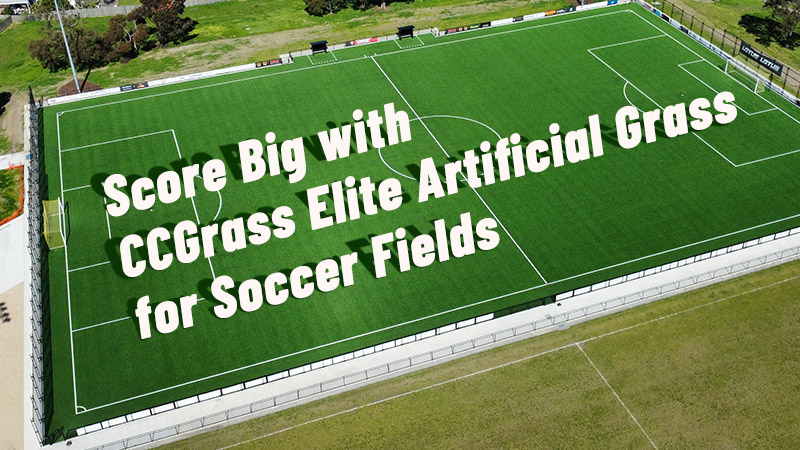
In this article:
Benefits of using artificial grass for a soccer field
Since artificial turf emerged as a viable and cost-effective alternative to natural grass, it has become a staple for the majority of schools, universities, sports centers, and clubs. Behind this trend lie several significant advantages offered by synthetic turf.
Extended playing hours: Artificial grass soccer fields enable extended playing hours unaffected by daylight or seasonal changes. They withstand heavy usage and diverse weather conditions, benefiting clubs and venues with high demand for field access or in regions prone to inclement weather.
Consistency and safety: With a consistently even playing surface, synthetic soccer fields foster fair gameplay and reduce injury risks. This allows players to focus on their performance, ensuring a safer and more enjoyable playing experience.
Clean and mud-free: While the thrill of playing in mud may appeal to some players, others prefer a cleaner experience on the field. Certainly, the absence of dirt is a significant advantage, not only for players who dislike muddy conditions but also for reducing the hassle of post-game washes.
Easy maintenance: Artificial turf needs minimal care compared to natural grass. Simple tasks like regular cleaning and grooming ensure consistent playability, saving time, money and resources for soccer pitch maintenance.
Supports multi-use: Synthetic turf can accommodate various sports and activities beyond soccer, such as football, field hockey, rugby, and recreational events, maximizing utilization of the playing field.
Artificial Turf Soccer Field Solutions at CCGrass
Our artificial soccer turf solutions feature:
FIFA-compliant artificial grass for soccer field
As a FIFA Preferred Producer, CCGrass soccer products meet all requirements of the FIFA Quality Programme.
This means that CCGrass’s artificial grass soccer systems excel in all FIFA tests, such as ball roll, vertical ball rebound, shock absorption and skin friction. Over 180 CCGrass artificial soccer turf systems have been tested and recognized to comply with FIFA standards.
| Test | Vertical ball rebound | Ball roll | Rotational resistance | Shock absorption | Deformation |
| FIFA Quality | 0.6 to 1 meter | 4 to 10 meter | 27 to 48 Nm | 57 to 68% | 6 to 11 mm |
| FIFA Quality Pro | 0.6 to 0.85 meter | 4 to 8 meter | 32 to 43 Nm | 62 to 68% | 6 to 10 mm |
Versatile soccer field solutions
CCGrass, a leader in outdoor and indoor artificial turf soccer surfacing, provides solutions to meet various soccer field requirements, including full-size stadium fields, training centers, and indoor soccer facilities, as well as smaller 5, 7, or 9 side pitches.
Our high-performance artificial grass for soccer field is trusted by top clubs like Chelsea and Olympiacos FC for their training grounds.
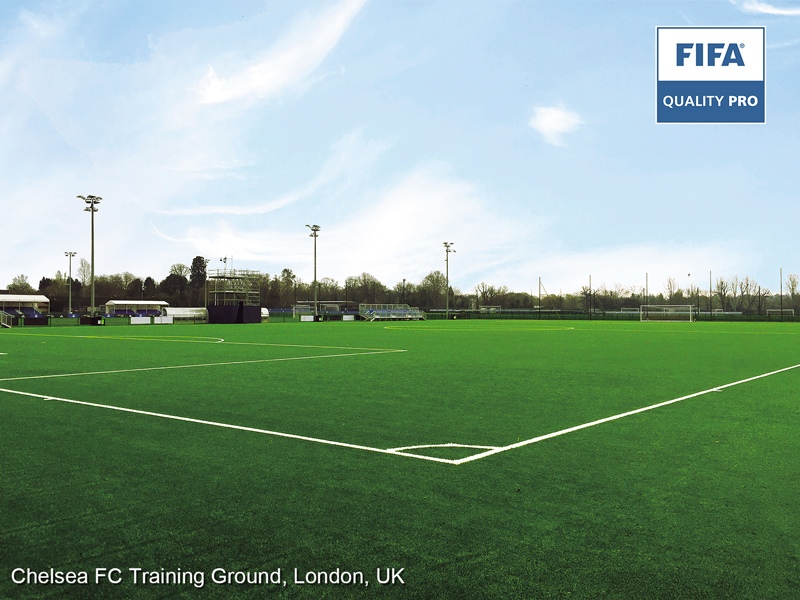
State-of-the-art soccer turf systems
Using natural grass fields as our benchmark, CCGrass has conducted comprehensive research on various aspects of turf performance, including playability, durability, and safety.
With our openness and robust manufacturing capacity, we consistently pioneer innovations to provide clients with uniquely designed soccer turf systems. In addition to mainstream 3G systems, we’ve also developed non-infill turf systems.
Recommended Soccer Turf Products
Superb Series
Enhanced by advanced C8 polymer and strong diamond shape, the Superb sets new standards for performance and longevity. With optimal durability, resilience, and softness, it delivers an unparalleled sports experience, catering to soccer, football, rugby, and beyond.
- Diamond shape yarn, 400µm thickness
- Lisport 550,000 cycles
- Lisport XL 25,000 cycles – The most durable in the market
- 12-15 years warranty
- Super sports performance
Vmax Series
Vmax Series utilizes a dual-yarn composition that minimizes infill splash whilst ensuring the playing surface is consistent, durable, and of elite quality. The Vmax is known for its quality and performance as an asset to clubs and facilities.
- Resilient V shape monofilament plus the long fibrillated yarn
- Available in 3 different fibre colour combinations
- Compliance with FIFA Quality and Quality Pro standards
- Environmental friendly
Triplex Series
TriPlex is the premier surface for stadium and academy soccer. Each tuft includes three different fiber shapes that bring their own benefits; balancing durability with resilience and a soft touch, to create a unique product. Suitable for hockey as a second sport.
- Combination with 3 Different Shape Yarns
- Certified by FIFA and FIH
- More consistent ball roll speed
- More vibrant and attractive look
Max EX2 Series
Max EX2 Series makes the “One Turf” a reality, designed specifically for multi-sport use. Max fibers are soft to the touch and exceptionally resilient. When combined with thatch yarn, this turf replicates natural grass even more closely.
- Combination of monofilament with “thatch”
- Certified to FIFA, World Rugby and FIH
- Outstanding standability
- Very durable, resilient and attractive surface
PRT Series
The PRT Series stands out for its exceptional qualities, offering a 100% recyclable artificial grass solution. With a specially developed fabric backing, it’s both soft and eco-friendly. Plus, PRT boasts 5 times faster water permeability for swift gameplay even after heavy downpours.
- 100% recyclable artificial grass
- No latex, no PU, no coating
- Super water permeability
- Strong tuft lock
These systems can be used with recycled infill, increasing the environmental credentials of a facility.
FAQS about Artificial Grass for Soccer Fields
How to install artificial grass for soccer fields?
A great artificial grass carpet can look very cheap if not laid correctly. For a successful soccer turf installation, an experienced installation team is needed, with the right equipment and enough time to complete the work.
CCGrass provides professional installation support and collaborates with reliable installation partners worldwide to ensure the smooth progress of your project.
For guidance on installing artificial grass for a soccer field, watch our instructional video guide below:
How to maintain a synthetic grass soccer pitch?
Unlike natural turf, you don’t have to water synthetic turf, feed it chemicals, cut it, mark it out and restrict usage. An artificial soccer pitch can be used 24/7, 365 days a year. But, the more it is used the more important maintenance becomes. The cost of maintenance is a lot less than on natural turf, but just as important.
Here are some key rules:
- Keep it clean: removing leaves, litter and other debris helps reduce contamination that may affect the pitch drainage.
- Keep the infill regulated: this means ensuring the rubber crumb is kept constant from edge to edge, especially in high-use areas, such as goal lines.
- Keep the fiber upright: helps ball-to-surface and foot-to-surface interaction.
- Keep it safe: check the pitch for loose seams, dips or bumps.
How long does an artificial soccer field last?
The longevity of an artificial soccer pitch depends on the quality of the grass surface, maintenance practices, and usage intensity. Typically, warranties for full-size fields range from 8 to 10 years, with some exceptional yarns extending the period to 12 years. However, for smaller areas like five-a-side football, or training grounds, the warranty length may be shorter.
How often is artificial soccer turf replaced?
When your artificial turf pitch starts showing the following signs, it may be time to consider replacement:
- Your pitch fails to meet performance tests
- Rental bookings start to decrease
- Players start commenting negatively on the playing performance
- The drainage not working as effectively
- The fibers are wearing away
- The seams begin to open up
- Small tears in the carpet begin to show
Regularly inspect your pitch and promptly consider replacement if any of these signs appear to ensure proper performance and safety. If in doubt, ask for an independent inspection from a pitch consultant or test house.
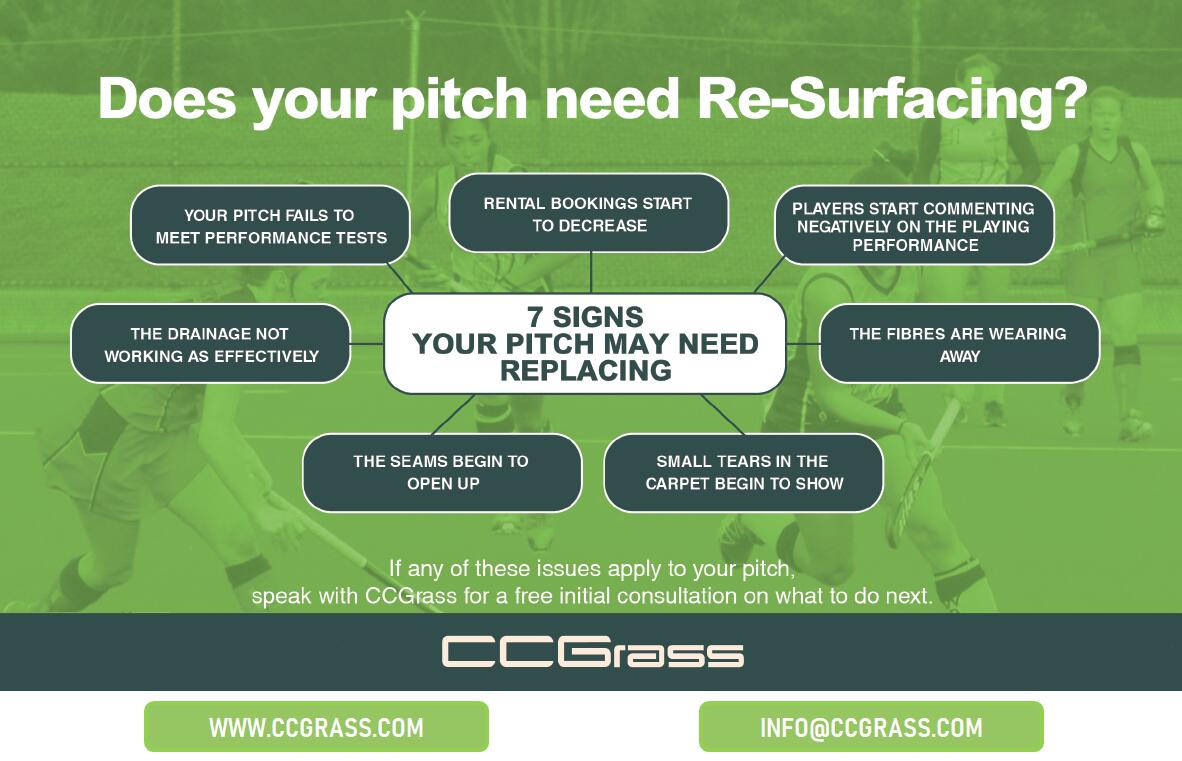
Get More Information on Building the Best Artificial Grass Soccer Field
Unless you have the ability to maintain high-quality natural turf, artificial grass for the soccer fields is the best option, providing many more hours of use, on a FIFA-tested, proven and safe surface.
Ready to install a top-quality synthetic turf soccer field? Trust CCGrass. Our expert team can guide you to the ideal surface solution tailored to your project’s needs. Get in touch with us today at 86 25 6981 1666 or via email at [email protected] to discuss your soccer turf needs.
Installing artificial grass can be a great way to transform your outdoor space, whether it’s a backyard, front yard, or even a commercial area. Not only does it provide a low-maintenance and attractive alternative to natural grass, but it also offers a range of other benefits, such as water conservation and durability.
However, when family homeowners consider the transition to artificial grass, queries frequently surface concerning its installation simplicity and the practicality of self-installation.
Further concerns generally relate to required maintenance procedures. To address these questions, we have collated a comprehensive guide outlining the process of artificial turf installation from beginning to maintain.
Whether you are a DIY enthusiast or a professional landscaper, these tips and techniques will help you master the art of artificial turf installation.
WATCH: How to install astro turf video:
In this article:
Artificial Turf Installation Process
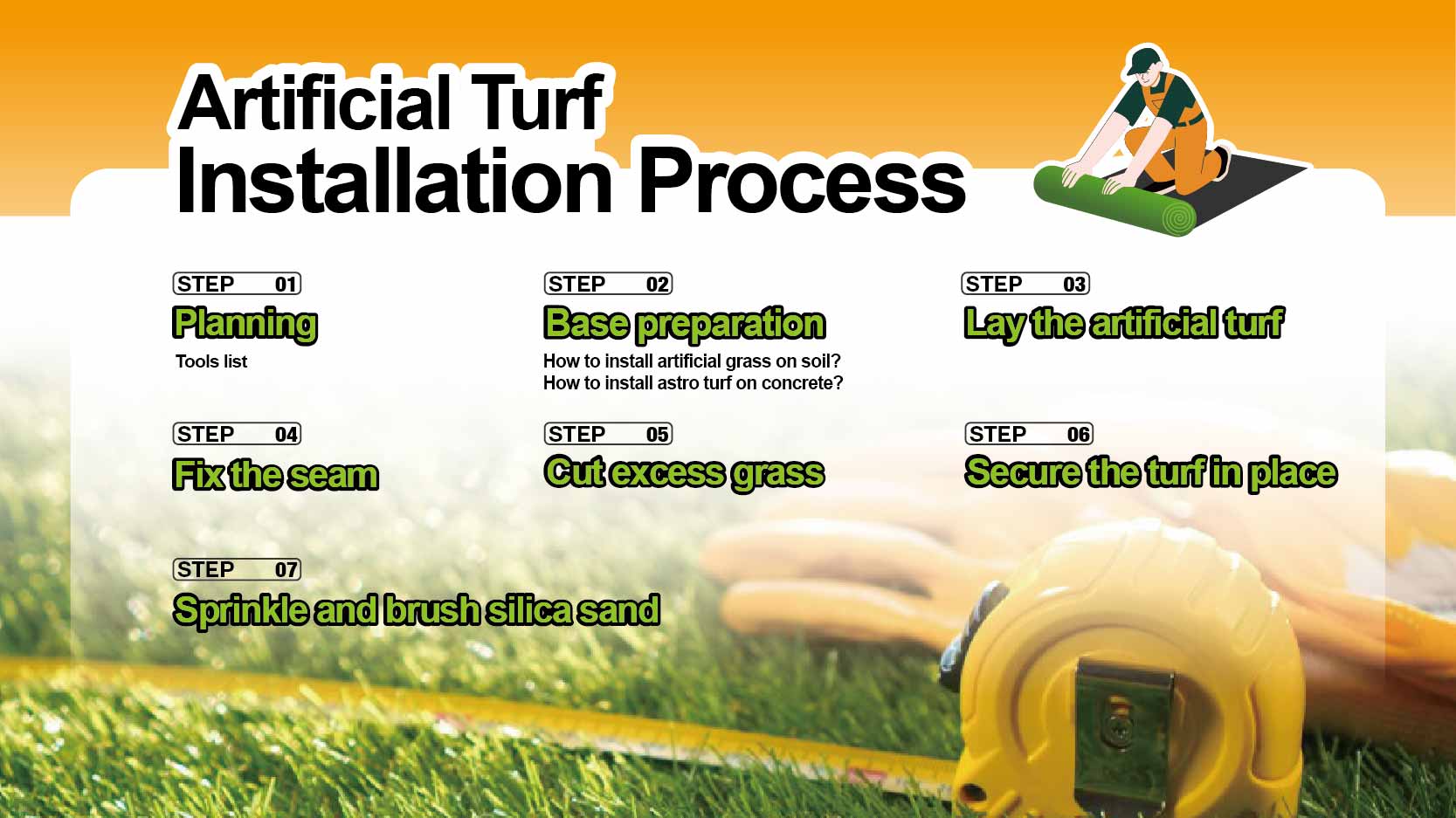
Step 1: Planning
The first step for artificial turf installation is to plan out and measure your garden, figure out how much artificial grass and which accessories you will need.
The astro turf has a width of 2m or 4m and a length of up to 25m. Roughly calculating how many rolls need to be ordered will help you avoid a high amount of waste and ensure that you don’t overspend, maintaining the project cost-effective.
Considering drainage is crucial during the planning phase, as it directly affects the turf’s durability. In areas with good natural drainage, extensive planning may not be needed.
However, if drainage issues exist, proper base preparation can often resolve them without resorting to expensive drainage systems. For further guidance on artificial grass drainage and solutions for common issues, refer to our article, “What You Should Know about Artificial Grass Drainage.”
Tools required for artificial turf installation
Next, what tools do you need to prepare for laying synthetic turf? It depends on the type and size of your installation. Some elements are optional, and some are essential.
- Tape Measure
- Sharp Knife
- Spade or shovel
- Hammer
- Bristle Broom/Grass Rake/Motorised power brush
- Gloves
- Pins/nails
- Self-adhesive Joining Tapeor Joining Tape plus Joining Adhesive
- Aroller or vibrating plate to compact the sand (both can be hired)
- Weed block cloth –This is optional, but we highly recommend it for outdoor installation.
- Shockpad – This is optional,especially recommended for concrete surfaces.
Step 2: Base Preparation
Fake grass can be installed on a variety of different surfaces. Here we will focus on the ground preparations for installing artificial grass on soil and concrete.
How to install artificial grass on soil?
a. Get rid of weeds
Before installing grass, the first thing you do is to kill grassroots and weeds. Spray the area with a non-toxic weed killer you trust. Weed killers need ample time to work, so it is recommended that you do this at least two weeks in advance.
b. Add the base material
Get rid of the top layer of soil, about 3 inches to make room for your new base.
Use a shovel to scatter your base material. Generally, in places with a mild climate, you can use gravel, crushed rock, decomposed granite, or any stones smaller than 3/8 inches as a base. Around 3 inches of the base material is needed to improve drainage and avoid slumping.
Use a shovel or sand spreader to lay sand 10-15mm thick on the top of your sub-base to provide a smooth surface.
c. Compact the base
Compact the loose material into a strong base with the help of a roller or vibrating plate (both can be hired).
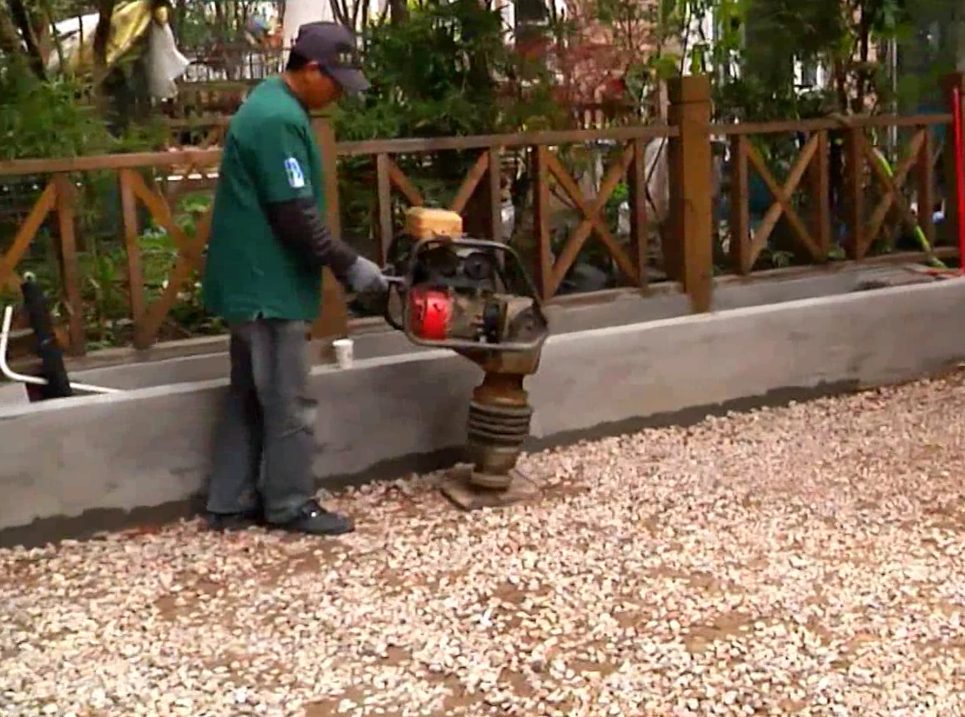
d. Optional: add a weed barrier
If necessary, after the base is compacted, cover the area with weed block cloth and secure in position with U-shaped nails around the perimeter.
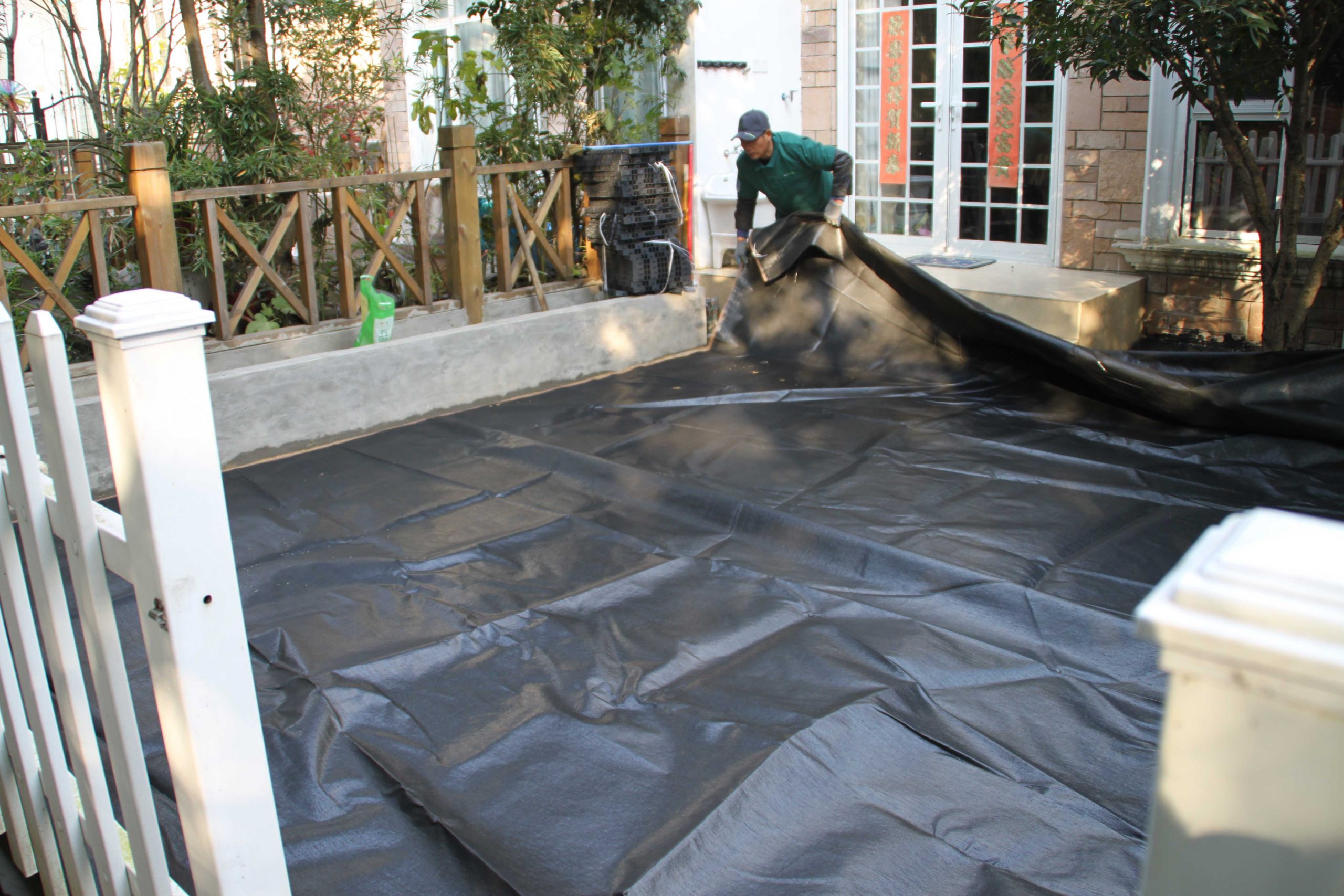
How to install an astroturf on concrete?
a. Clean existing concrete
The uniform standard for the base is that the surface needs to be smooth, clean and level. First, clean your area thoroughly, and then check for uneven surfaces. If they aren’t too uneven and can be fixed, you can use self-leveling compounds.
b. Optional: install the shock pad
While fake grass can be directly laid on concrete, it’s advisable to consider incorporating shock pads in specific applications like play areas or recreational spaces. This enhances safety with cushioning and adds an extra layer of comfort.
Step 3: Lay the artificial turf
Unroll the artificial turf over the area, being careful to not move the weed block cloth, and then let the turf sit in the sun for a few hours – this allows any creases to fall out as well as the condition of the grass yarn will be better.
If you are working with multiple rolls, it is very important that the yarn direction and stitch patterns are facing the same way. Crossing yarn directions will result in poor appearance. Having the yarn direction running toward the house will give the best look from the windows of the house.
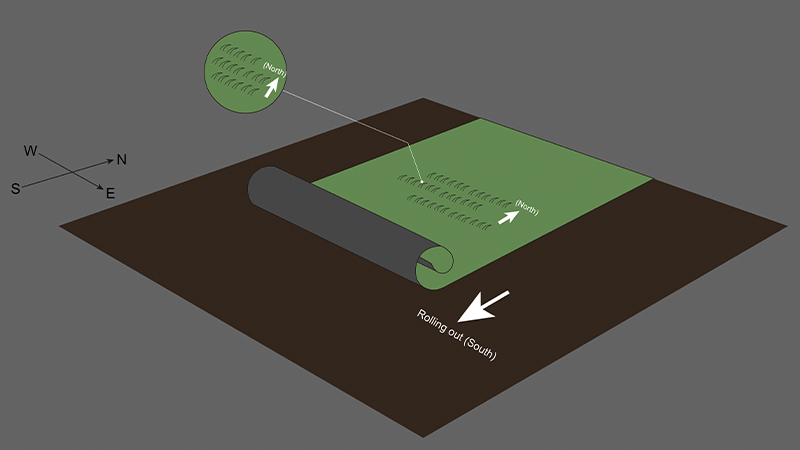
Step 4: Fix the seam
a. Cut off the manufacturing edge strip (if present) or cut off another stitch so that there is as little backing as possible next to the stitch and butt the two edges together.
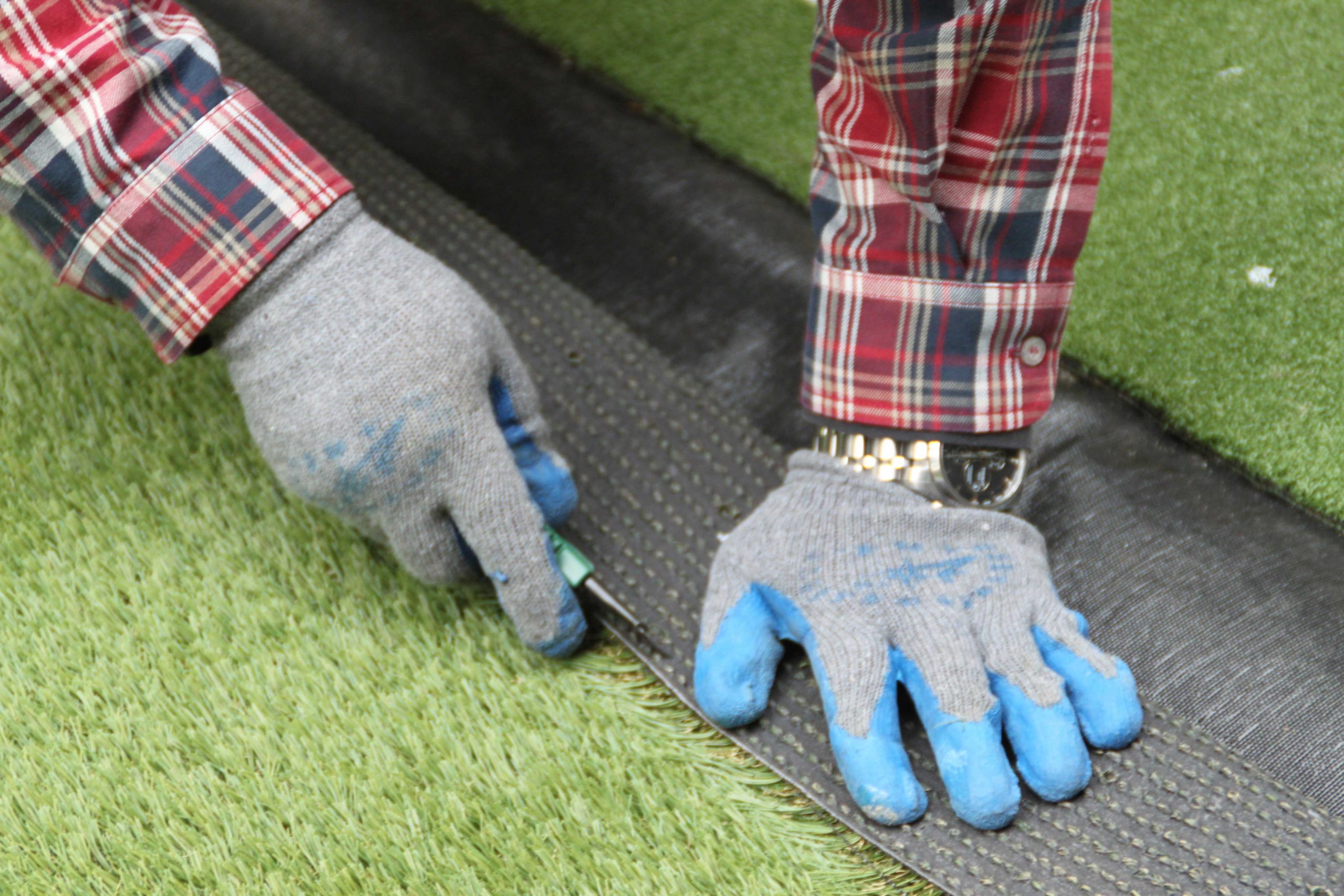
b. Fold back the edges and position self-adhesive jointing tape (smooth side down) so that the edges of the carpet meet down the centre of the tape when joined.
c. Fold the turf back into the adhesive tape starting from one end. Work your way down the seam carefully, joining the two pieces together. Make sure tufts aren’t damaged or buried.
Step 5: Cut excess grass
Trimming the excess grass around edges, corners, or obstacles is crucial for achieving a professional-looking installation. Here’s how to do it effectively:
a. Trimming around patio or garden edges
Hold the knife firmly and gently pull back the grass to expose the backing. Maintain a gap of no more than 1/8 inch between the backing and the patio edge while cutting.
b. Cutting against a wall or fence
Fold the turf back and press it tightly against the corner of the wall or fence. Place the blade against the backing where it lands closest to the wall, then lift the turf up and cut in increments of 6 inches at a time. Check the fit periodically by laying the turf back down, ensuring the backing is not too tight against the edges.
c. Relief cuts for corners, trees, or posts
Fold the turf back and make small outward relief cuts where the backing meets the object. Cut from point to point, fitting the grass to the exact curvature of the object.
Take your time during cutting to achieve a precise fit. The goal is for the grass to lay loosely around objects without touching them.
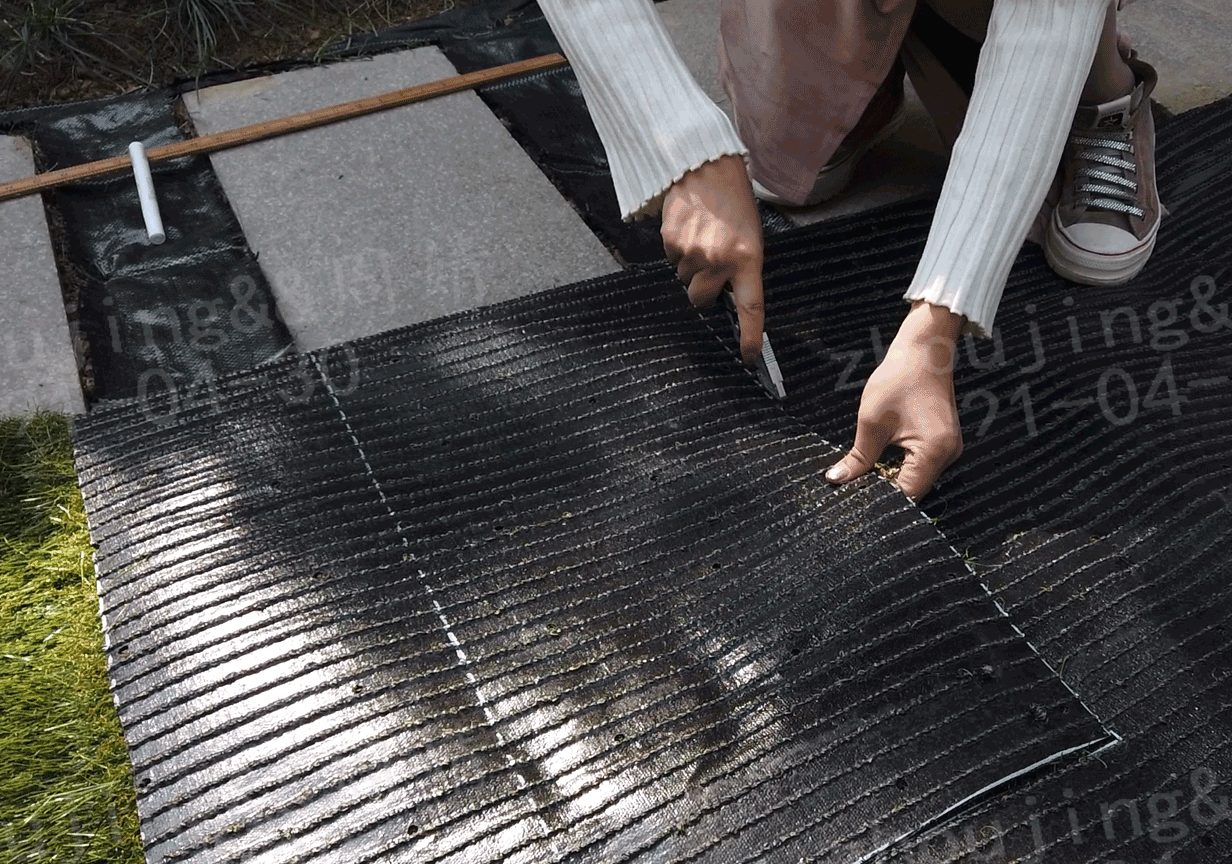
Step 6: Secure the turf in place
On soil: Secure the turf by stretching it taut and fastening it with landscaping pins placed every 6–8 inches along the perimeter. You can also place pins along the seam to secure the turf further.
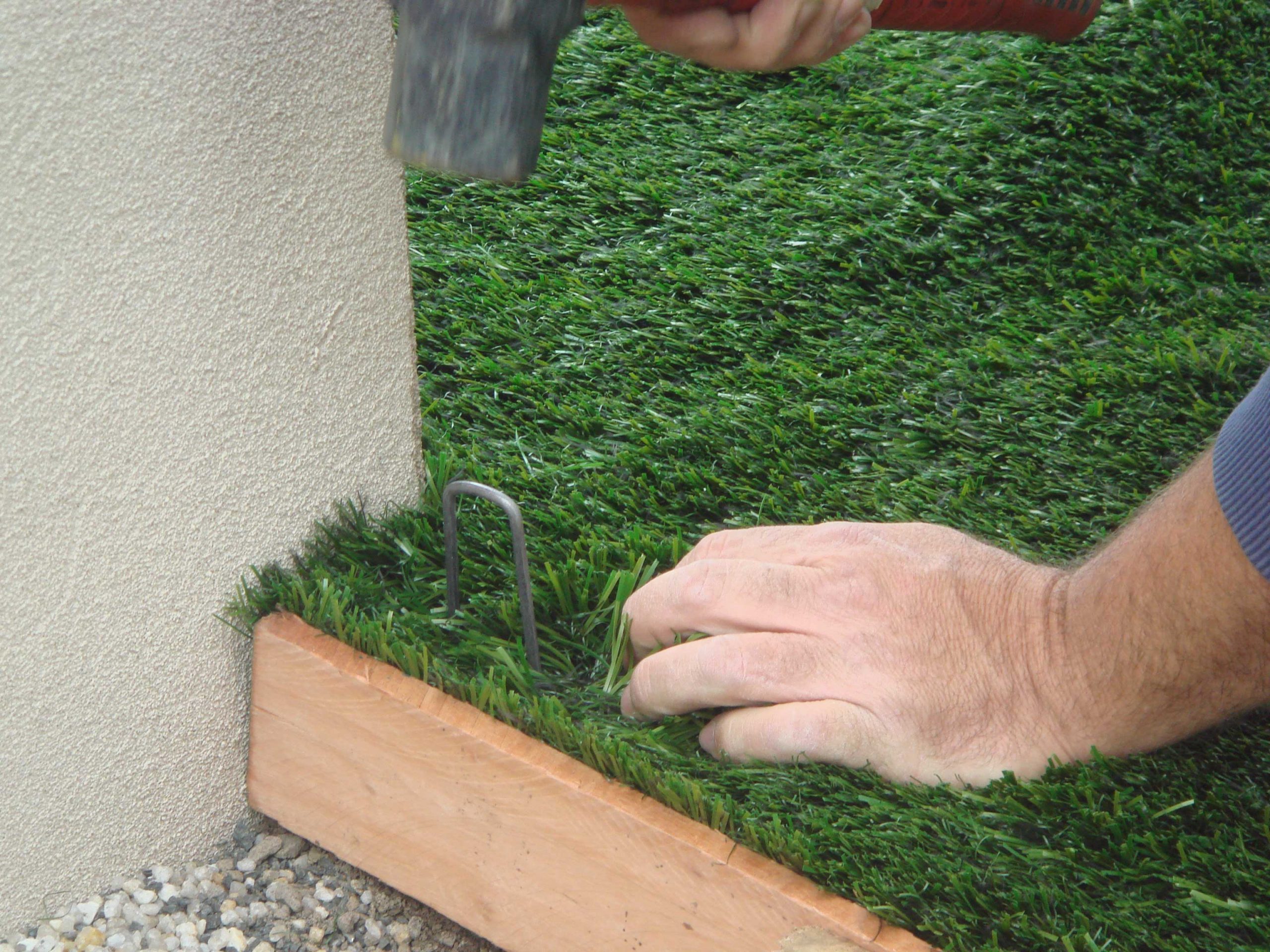
On concrete: Join the back of the artificial grass and concrete base with an adhesive every 6–8 inches along the perimeter. Alternatively, you can secure the edges with plants or other garden accessories.
Step 7: Sprinkle and brush silica sand
The final step for artificial turf installation is to spread silica sand across your astro turf, building the depth in layers. We recommend 6-8 kg of sand per square metre of lawn.
For the best results, we recommend using a bristle broom or a grass rake to brush the pile before, during and after. Brush against the pile fibre direction to encourage the individual grass tufts to stand upright.
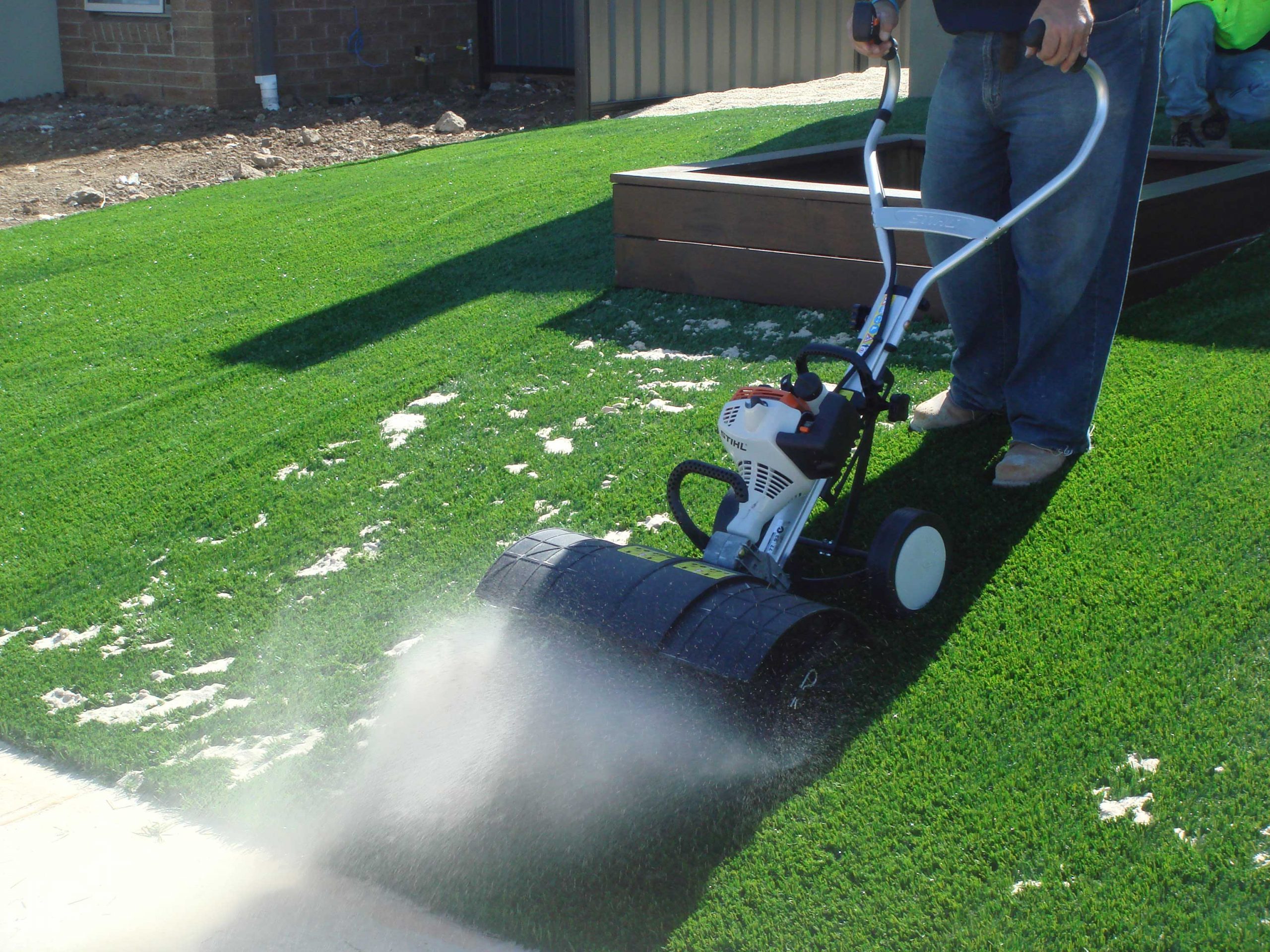
Post-Installation Maintenance and Care
Regular cleaning & brushing
Clear away debris
Clear any debris from your fake grass on a regular basis, particularly following storms or windy days. Leaves, branches, and other items tend to gather on the turf, affecting both its visual appeal and performance.
You can easily accomplish this task by hand-picking larger items and using appropriate tools like a leaf blower, broom, or soft-tipped rake to remove smaller debris.
Rinse the turf
Regularly rinse your artificial turf with water to remove dust, pollen, and any loose dirt. Depending on your location and the frequency of rainfall, you may need to rinse the grass more or less frequently.
Brushing for a natural look
Routinely brushing up the fibers of the grass (against the grain) helps maintain an upright position, resulting in a lush and vibrant appearance for your lawn. Use a stiff-bristle broom or a specialized turf brush for this task.
Remove stains promptly
Spillages can be washed away with water. For lightly soiled areas, a simple solution of warm water and a small amount of mild detergent will do the trick. Wipe it with a sponge, then rinse.
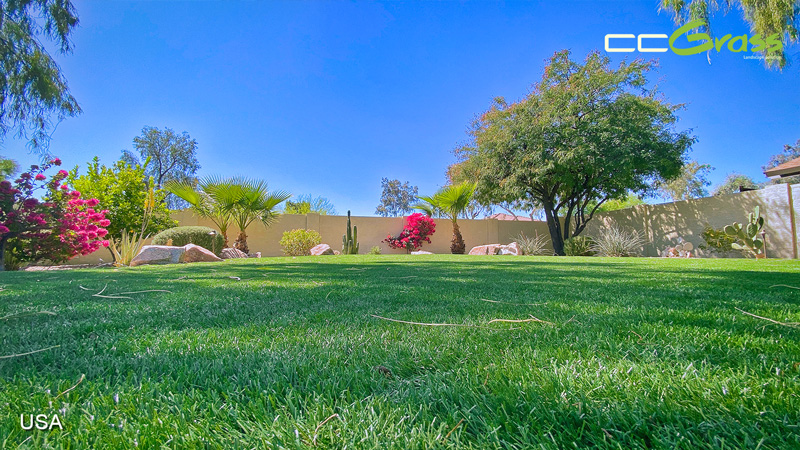
Handling pet waste
a. Dealing with pet urine
Thanks to the drainage backing, the urine is naturally handled. You don’t have to clean the turf after every urination. It’s suggested to hose down the turf once a week, especially if it hasn’t rained, to remove any residue.
b. Cleaning up pet feces
Cleaning up pet feces from turf resembles caring for natural grass. Let the waste dry a bit to prevent smearing, then use a doggy bag or scooper for solid waste. In the case of diarrhea, remove as much as possible with a bag or paper towels. Lastly, thoroughly rinse the turf fibers with a hose to ensure cleanliness.
Repairing damaged artificial turf areas
a. DIY repairs for small areas
For minor damages, replacing the damaged patch may be a simple DIY project. It’s always advisable to retain leftover turf from the initial installation to use for repairs, ensuring the best color match.
Trim the damaged turf and place the new piece in the original location, aligning its fibers with those of the existing turf. Secure the turf with nails and a hammer, adding infill for consistency and appearance.
b. Professional help for larger areas
For more extensive damage, it may be necessary to enlist the services of professional turf installers to ensure a seamless repair.
Conclusion
There are pros and cons to hiring professional install crews or DIY artificial grass installation, and you need to evaluate your situation objectively and decide based on your budget. DIY artificial turf installation may seem like a daunting task, but it could also be a fun activity for the family.
CCGrass, the world’s leading artificial grass manufacturer, is dedicated to providing the best artificial turf for both sports and landscape purposes.
We manufacture a complete range of artificial turf applications for residential, commercial, DIY, pets, golf, city landscape and many more purposes.
Our wholesale partners are all over the world, including dealers, retailers, supermarkets, engineering contractors, etc., which means that the products have been widely recognized.
If you are interested in wholesale artificial grass, or have any questions about artificial turf installation and maintenance, please call 86 25 6981 1666 or email [email protected].
Recently, some entities in the market have been unauthorizedly counterfeiting our artificial turf product “SuperbTM”, engaging in activities such as manufacturing, promotion and sales, which seriously infringe upon the legitimate rights and interests of our company and the final consumers.
SuperbTM is a high-end sports grass product, which is independently developed and manufactured by CCGrass. Please recognize our official product name “Superb CCGrass” and our new official logo (as attached below).

The counterfeit product fails to meet the high-quality standards we set for our “SuperbTM” and may adversely impact the performance and safety of your sports fields, while simultaneously engendering sustained apprehensions related to upkeep and post-purchase support services.
We strongly advise all customers to ensure your purchases of this product are made through our official sales channels. If you become aware of the manufacture, promotion or sale of products that appear to be imitations of our SuperbTM or other products, welcome you to provide us with any relevant information. Your support helps maintain a fair and clean market environment. Thank you.
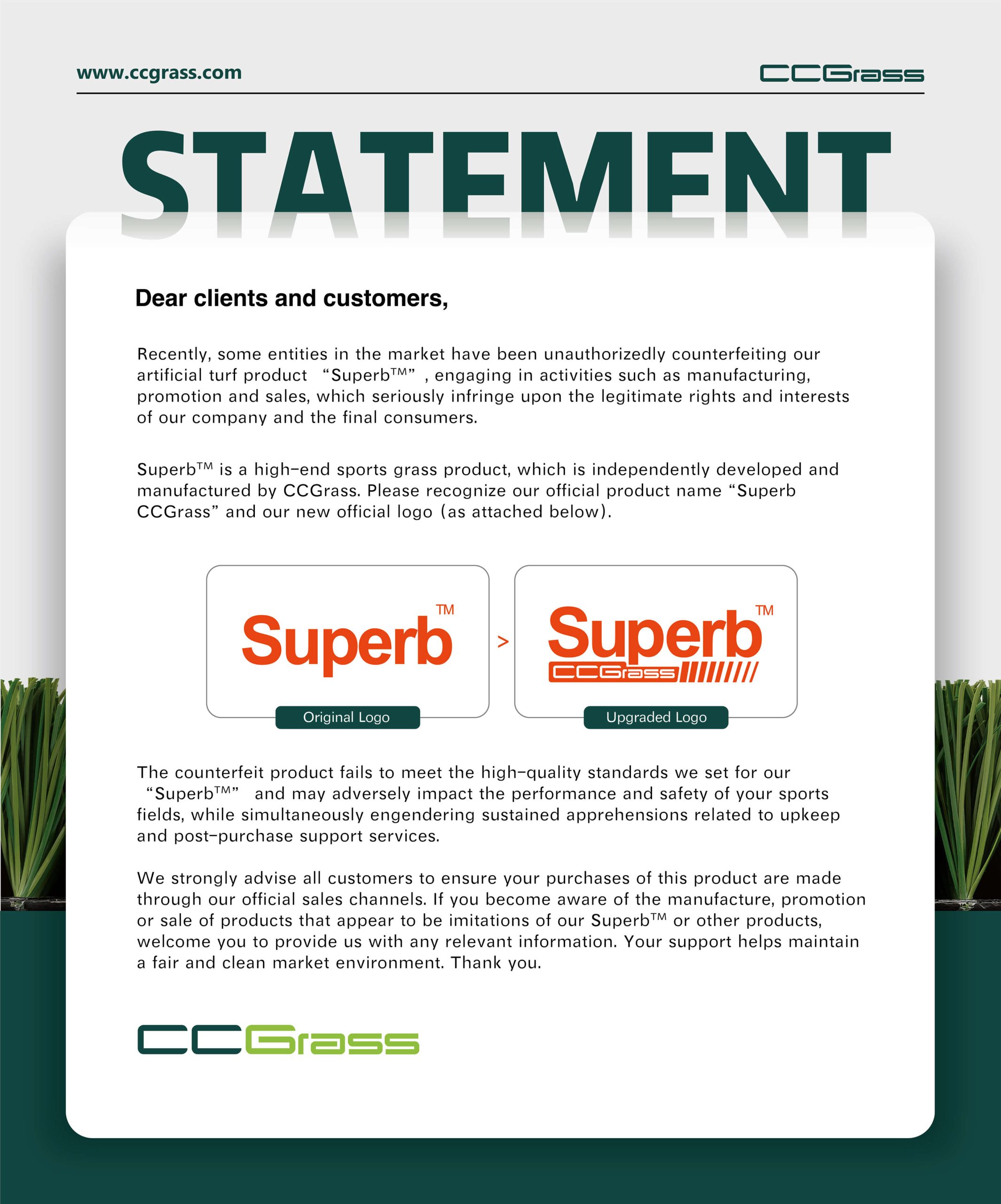
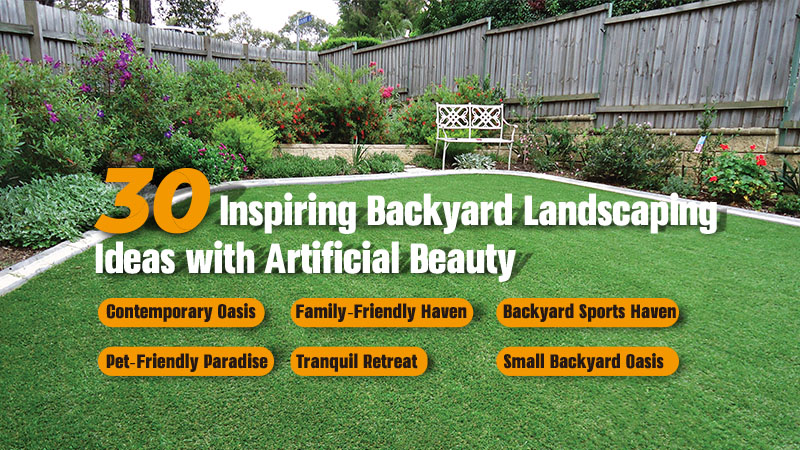
Ready to turn your backyard into a captivating haven? Immerse yourself in a trove of over 30 creative and inspiring backyard landscaping ideas featuring artificial grass that cater to every style and need.
From contemporary oases and family-friendly designs to sports havens and backyards of versatile, varying sizes, discover a world of possibilities to elevate your outdoor experience.
Contemporary Oasis – Where Comfort Meets Style
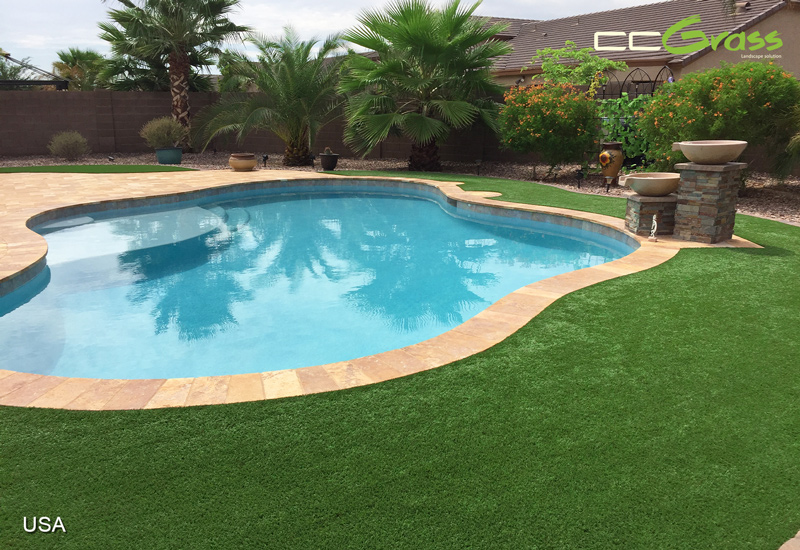
1. Artificial grass around the pool offers a comfortable, slip-resistant surface for barefoot enjoyment post-swim. Its excellent drainage keeps the area clean and tidy, free from water puddles or mud, ensuring a pleasant swimming environment.
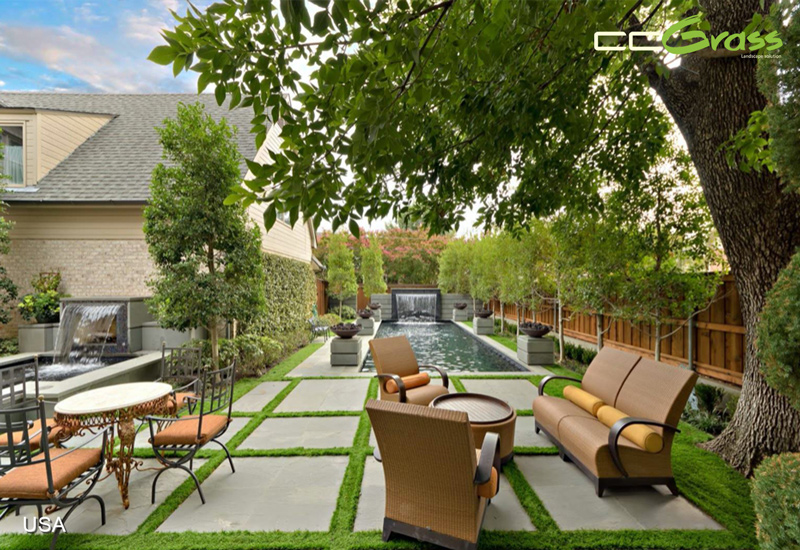
2. The backyard’s artificial grass enhances the natural aesthetic, and the concrete pavers add a modern flair. Moreover, no concerns about trimming or maintaining these perfectly shaped grass patches and strips.
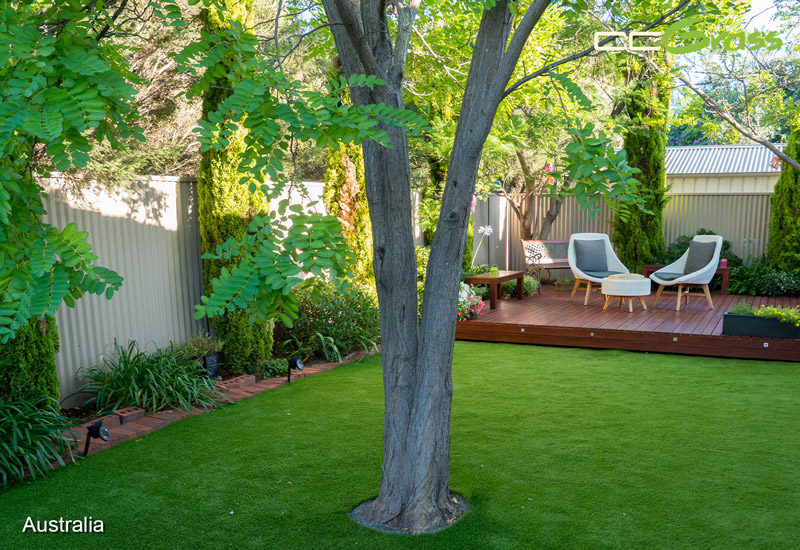
3. Elevate your outdoor space with a floating deck embraced by lush synthetic turf, merging nature and sophistication.Furnished with chic furniture, it’s the perfect spot to relax, soak up the sun, and enjoy a tranquil escape.
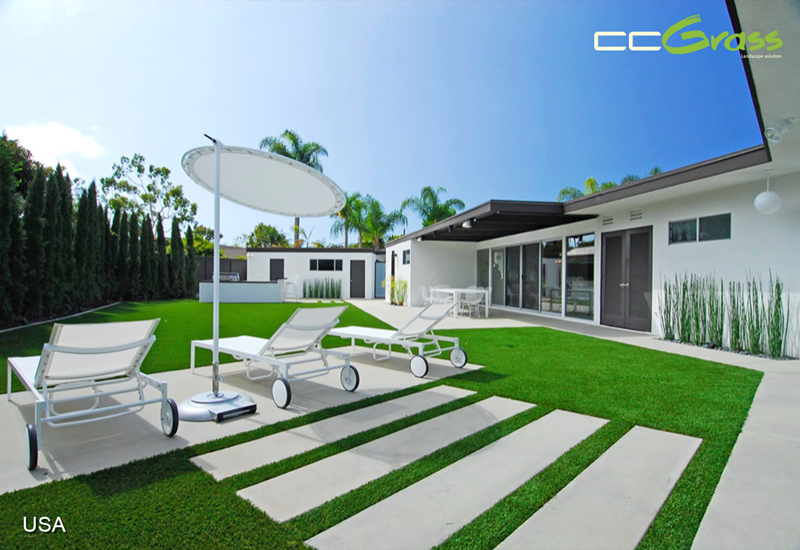
4. Delicate backyard with sleek design. Fakegrass ensures easy maintenance, promoting tranquillity. Pair with minimalist furniture for a modern, clean aesthetic.
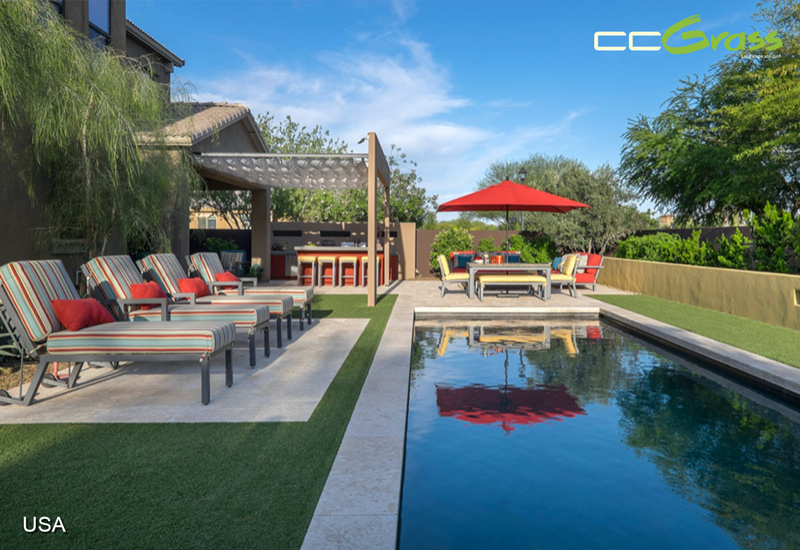
5. Bar counter, dining area, swimming pool, lounge chairs, artificial turf… Extend your living space outdoors.
Family-Friendly Haven – Unleash Joyful Play and Togetherness
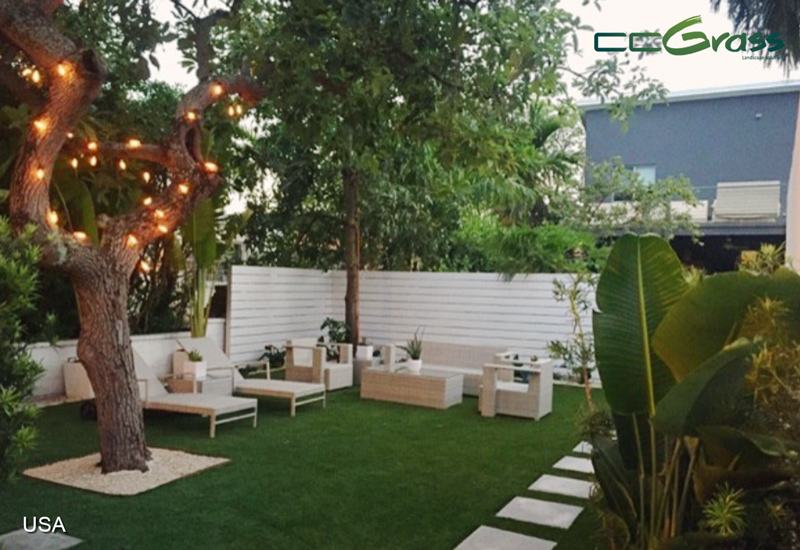
6. The lush surroundings, paired with outdoor sofas, and loungers, create a cool and inviting relaxation spot in your backyard. As night falls, illuminate the space with string lights, adding a warm ambience – an ideal spot for family gatherings and casual conversations.
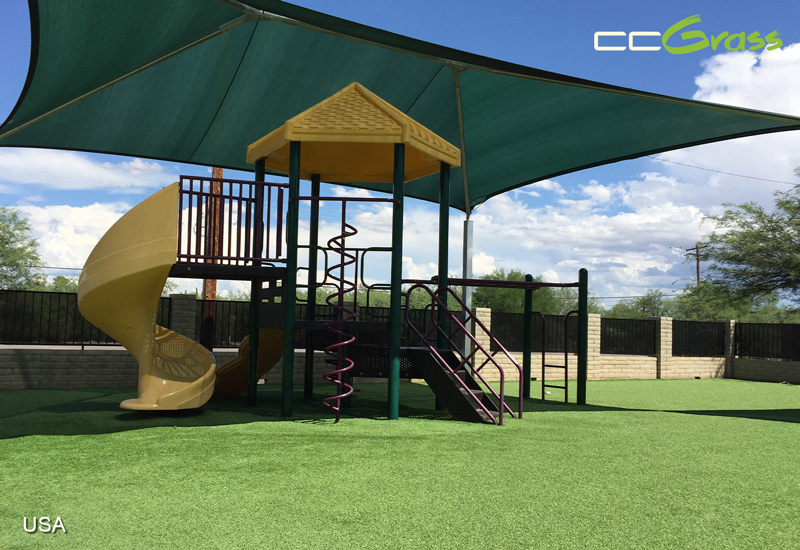
7. Create lasting childhood memories by designing a safe and soft play area for children. Swing, slide, climbing frame, or bouncy trampoline, along with artificial turf, form a family-friendly haven that encourages play and togetherness.
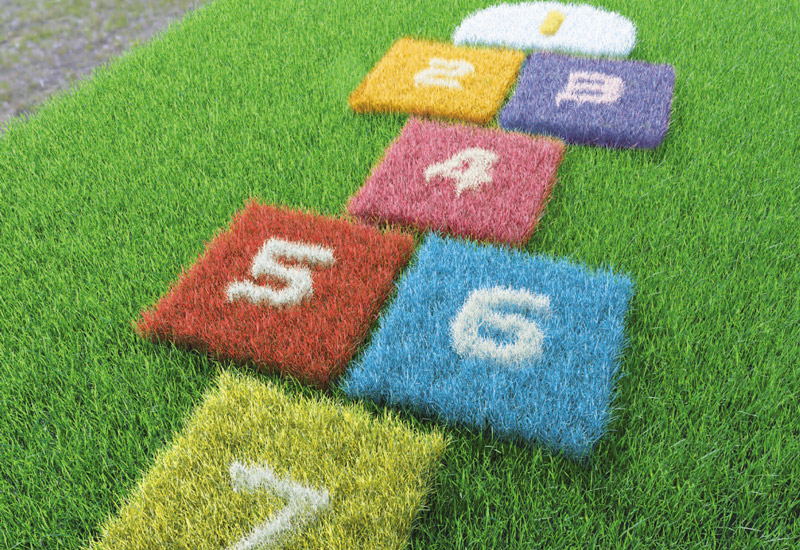
8. CCGrass 3D Art Grass – Portable Hopscotch: designed to incorporate elements such as numbers, letter paths or hopscotch, can be inserted into playground surfaces to create interactive play elements.
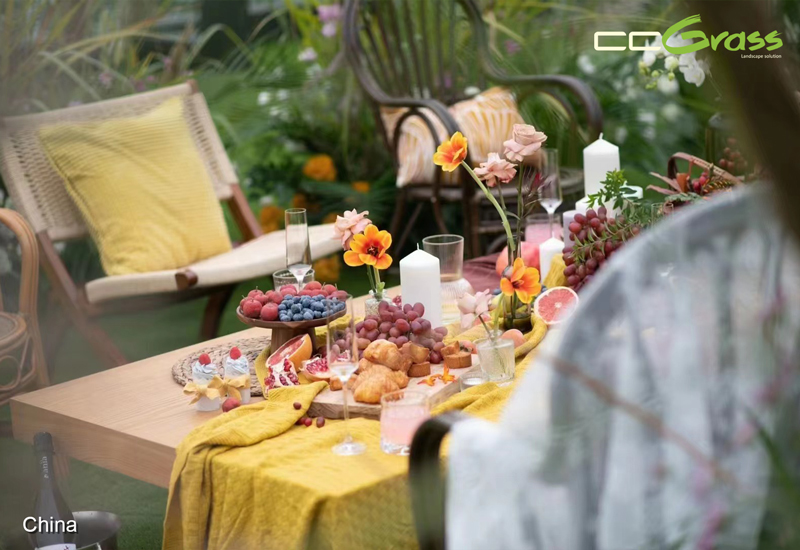
9. Designate a picnic area with a cosy blanket, cushions, and a low table. Enjoy outdoor meals together surrounded by the beauty of nature, making it a perfect setting for family picnics and creating cherished memories.
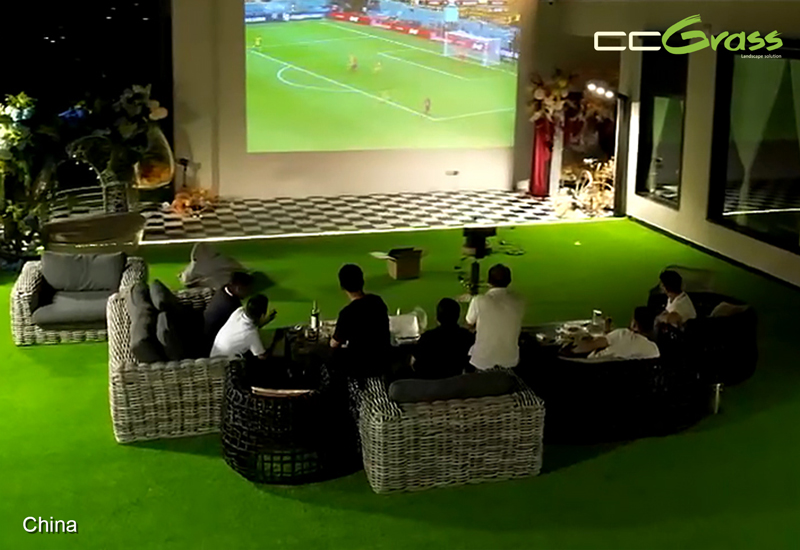
10. Set up an outdoor movie screening area with a projector and a blank wall or screen, while artificial grass surface under your foot provides you comfort and safe feeling. Cosy up with blankets and pillows for a family movie night under the stars.
Backyard Sports Haven – Elevate Your Game, Elevate Your Space
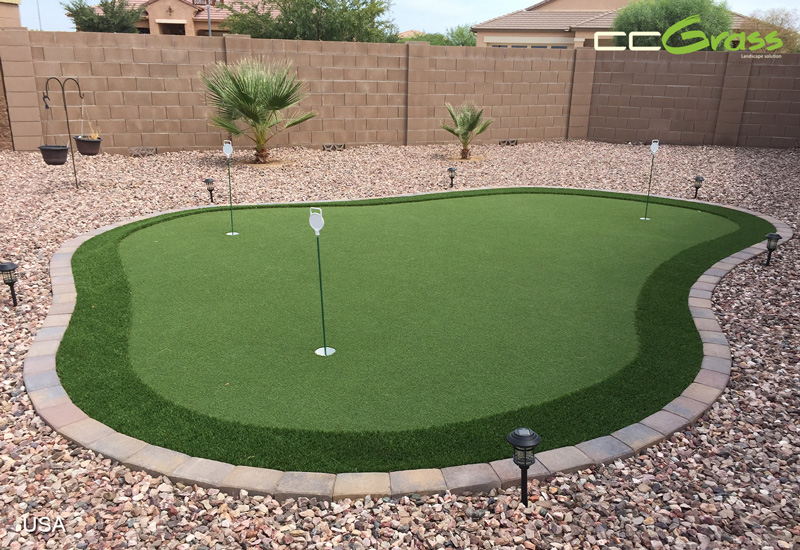
11. Design your backyard putting course with premium artificial grass, delivering an authentic golfing experience. Minimal upkeep, maximum home practice. Additionally, enhances property value.
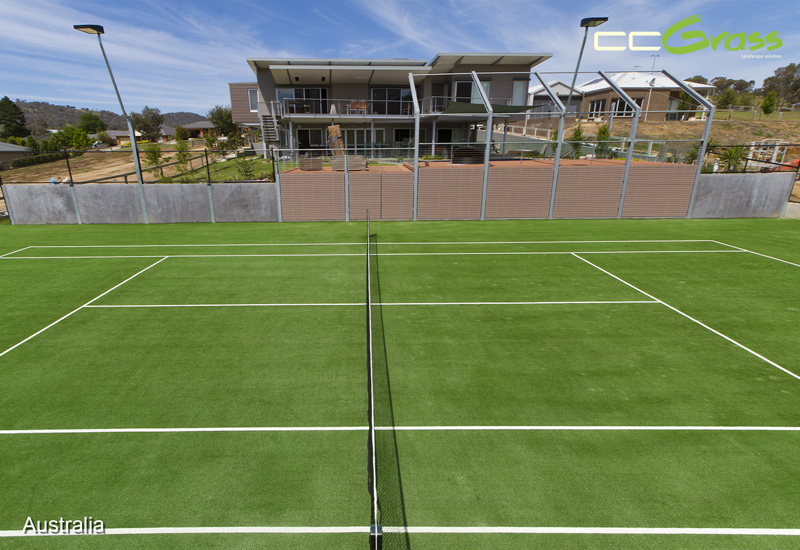
12. Ideal for professionals and enthusiasts alike, bring Wimbledon to your backyard with a CCGrass artificial grass tennis court, offering a professional-grade experience for practice and competitive play.
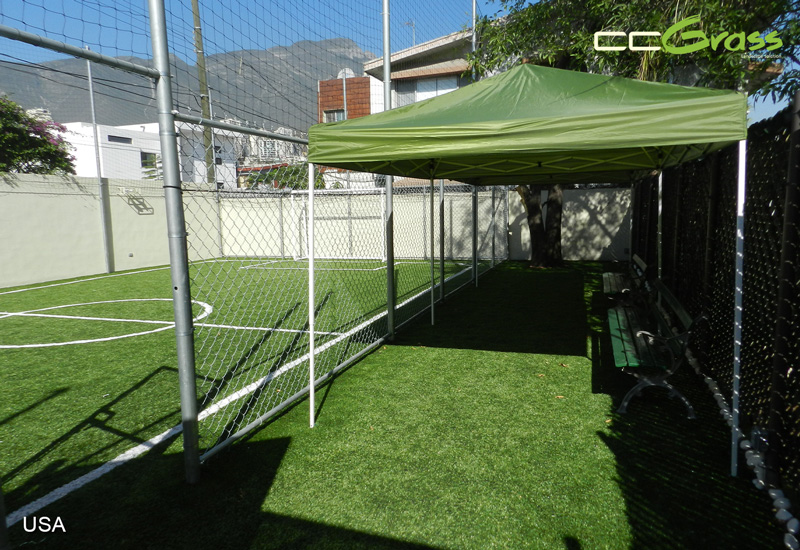
13. Experience the thrill of a backyard-enclosed soccer field, thoughtfully designed with a spectator zone and equipped with a sunshade canopy. Gather the children for a family football match, and the excellent synthetic turf creates a real sports experience.
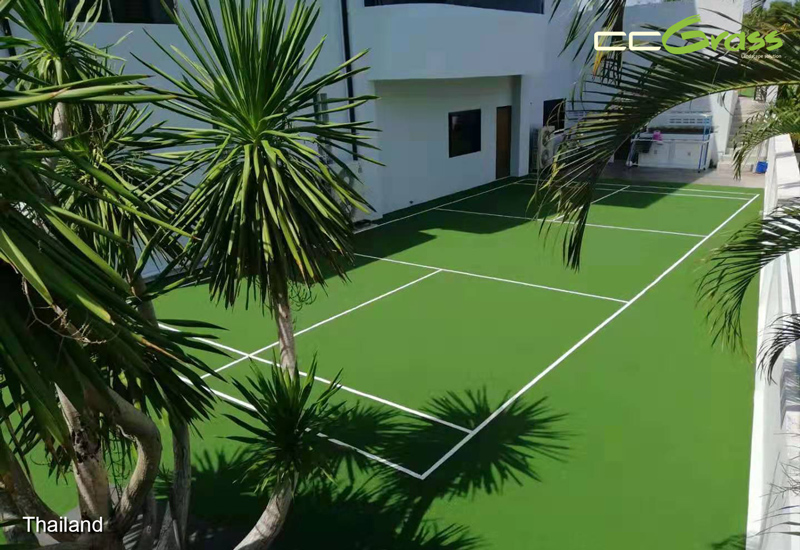
14. Utilize your small backyard for badminton bliss. Install a compact court with artificial turf for a charming retreat, combining sporty fun with greenery in a cozy setting.
Go Modern – Fusion of Hardscape Elements
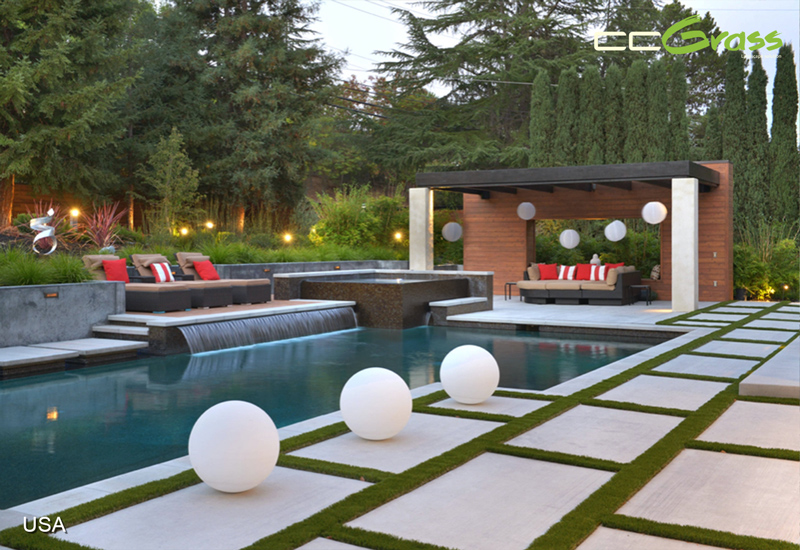
15. In this ample backyard, a chic water feature blends seamlessly with a charming observation terrace. Artificial grass and pavers bring a natural and balanced feel to the entire space. The well-crafted patio offers a tidy and comfortable space for outdoor activities.
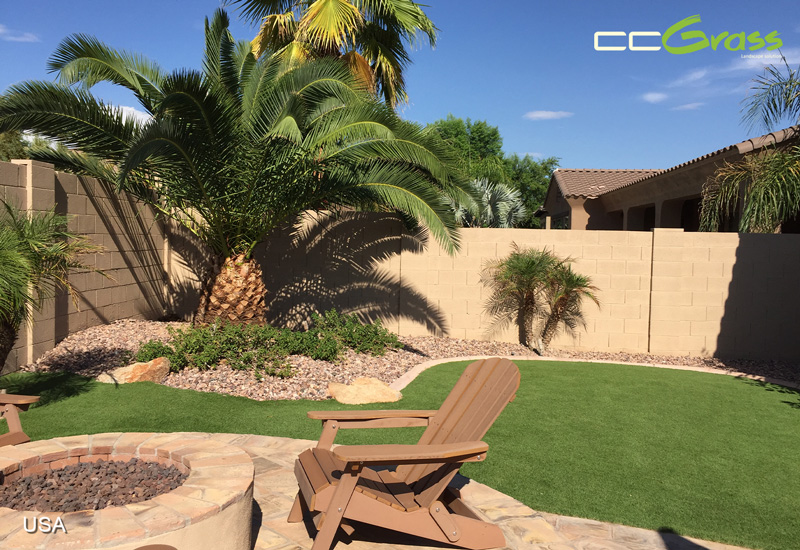
16. A modern fire pit in your backyard serves as a gathering spot infused with warmth. The vibrant surrounding artificial turf softens the hardscape, fostering an inviting and cohesive ambience.
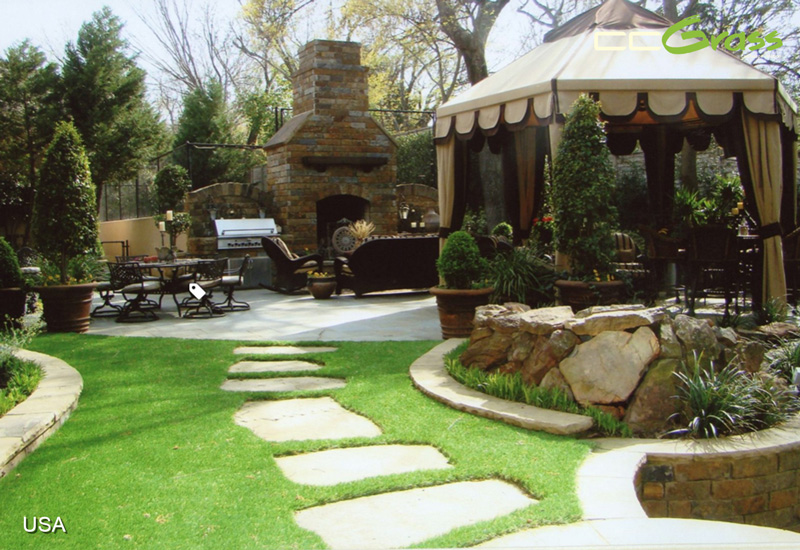
17. A fantastic backyard is a place for day-long enjoyment. Integrate synthetic grass pathways, a stylish arbor, a cozy fireplace, a barbecue zone, and a laid-back spot for meals and gatherings to create a functional outdoor retreat.
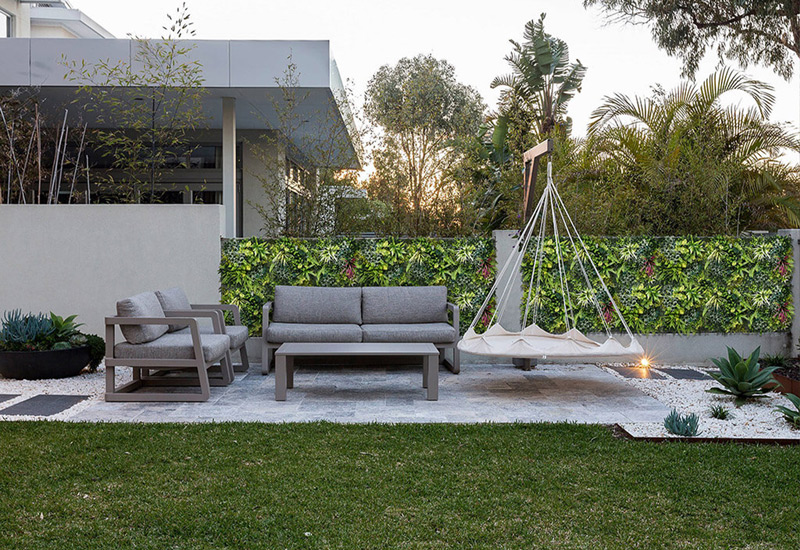
18. In this outdoor design, diverse flooring materials define and connect distinct zones. Understated paving slabs with white gravel create a chic resting area. A wall garden adds privacy and brightens up the space.
Pet-Friendly Paradise – Tail-Wagging Bliss for Furry Friends
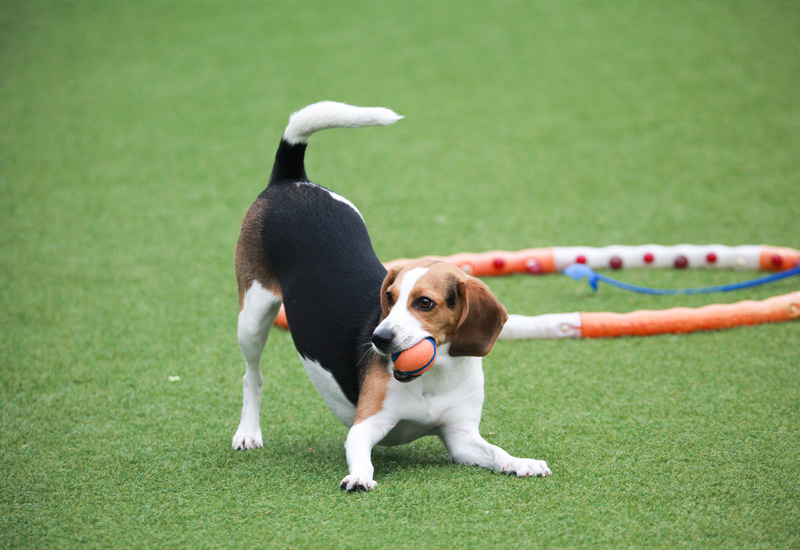
19. Build a mini-dog park in your backyard with soft, durable artificial turf for your furry friends to play. Experience the convenience and low-maintenance benefits simultaneously.
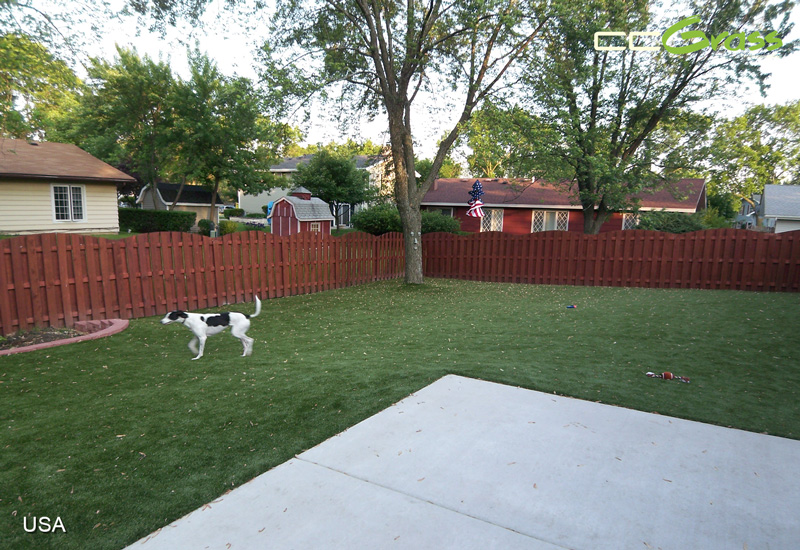
20. This pet-friendly space serves as a dog potty and dog run, blending nature and functionality for an ideal canine oasis.Let your dog run on the comfortable lawn and unleash his athleticism.
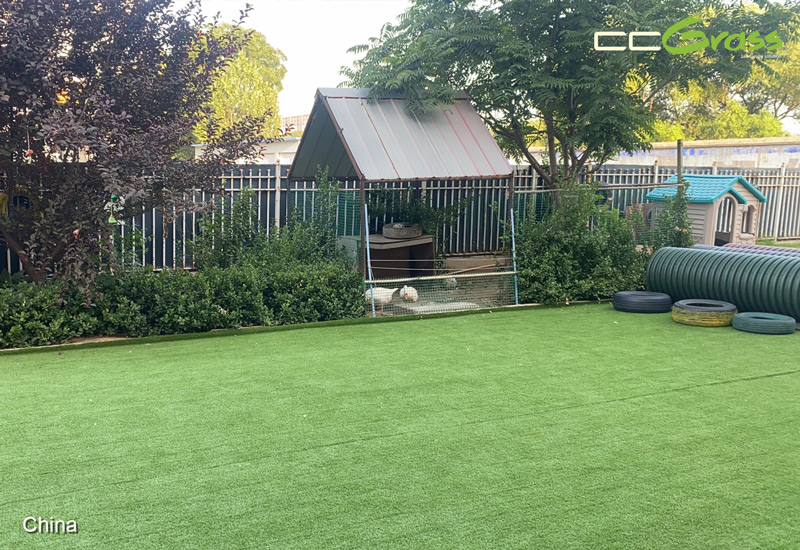
21. Establish a welcoming pet rest area adorned with artificial grass, providing a clean and comfortable space for pets to rest and recharge.The low-maintenance faketurf frees up your workforce.
Tranquil Retreat – Calm Your Senses in Nature’s Embrace
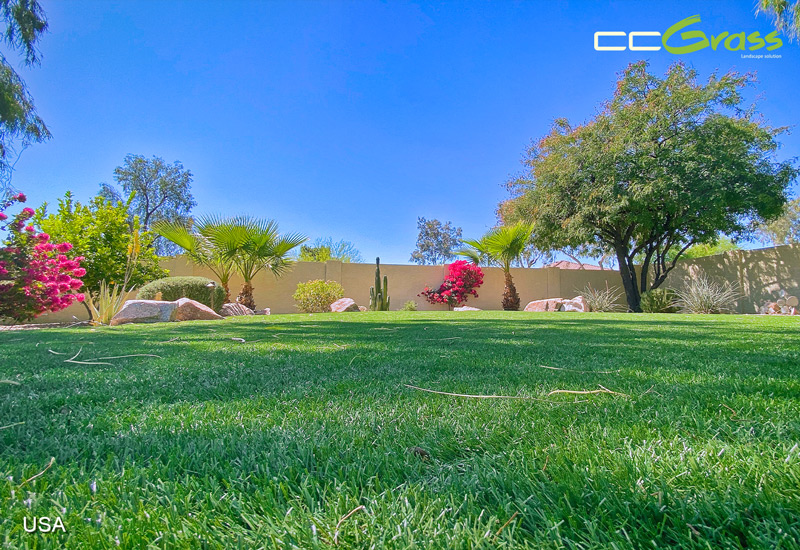
22. Elevate your backyard garden with a lifelike and low-maintenance artificial lawn, seamlessly harmonizing with existing flora. Relish the serenity, freeing more leisure time for pure enjoyment.
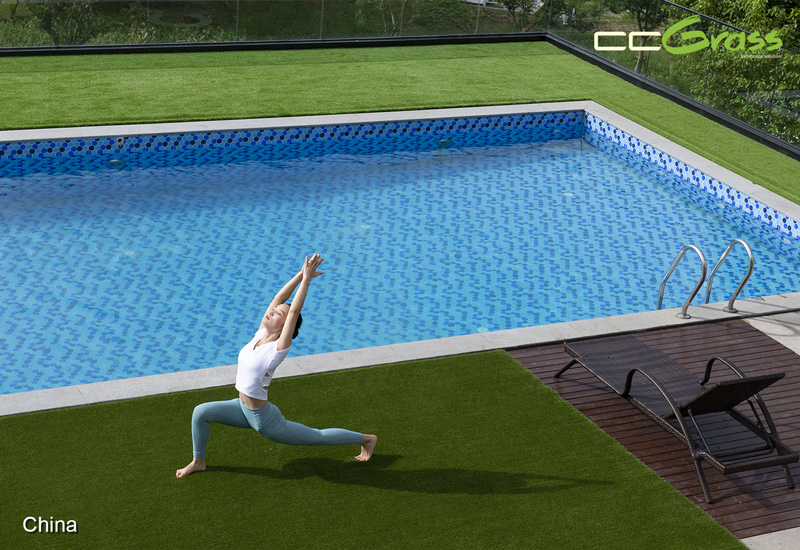
23. Awaken your senses with yoga on the artificial turf by the pool. This peaceful space becomes a haven for meditation and relaxation.
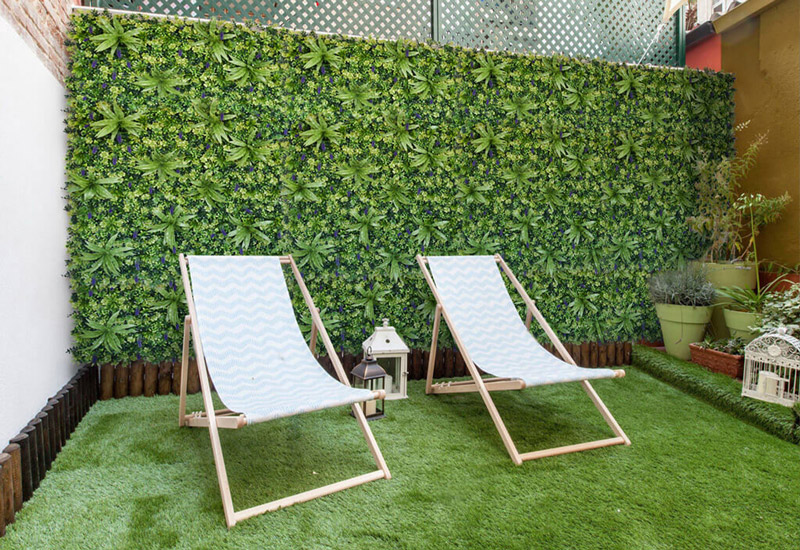
24. Create a peaceful nook with artificial grass and an artificial green wall, giving you the sense of being surrounded by nature and ensuring privacy.
Large Backyard Bliss – Grand Scale Landscaping
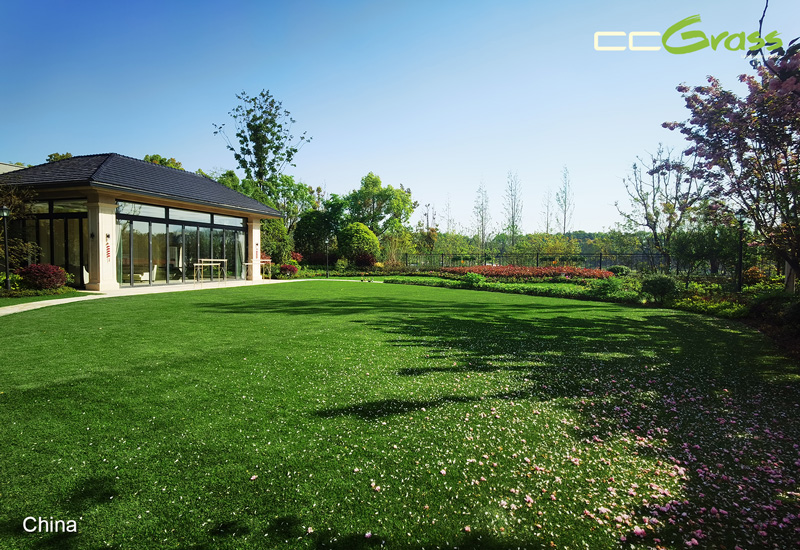
25. Transform your large backyard into a sea of lush turf lawns, creating a serene and expansive green canvas that extends as far as the eye can see. Easy upkeep means more time to enjoy your green garden all year round while saving significant water resources.
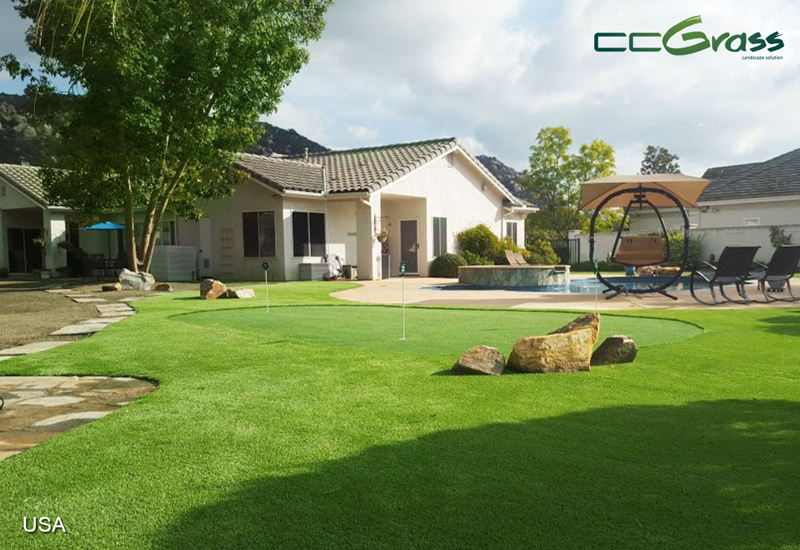
26. This expansive and inviting backyard boasts an artificial putting green, a swimming pool, and comfortable seating – ideal for both relaxation and entertainment. Versatile, low-maintenance, and customizable to any size or shape, artificial grass opens up endless possibilities for your backyard.
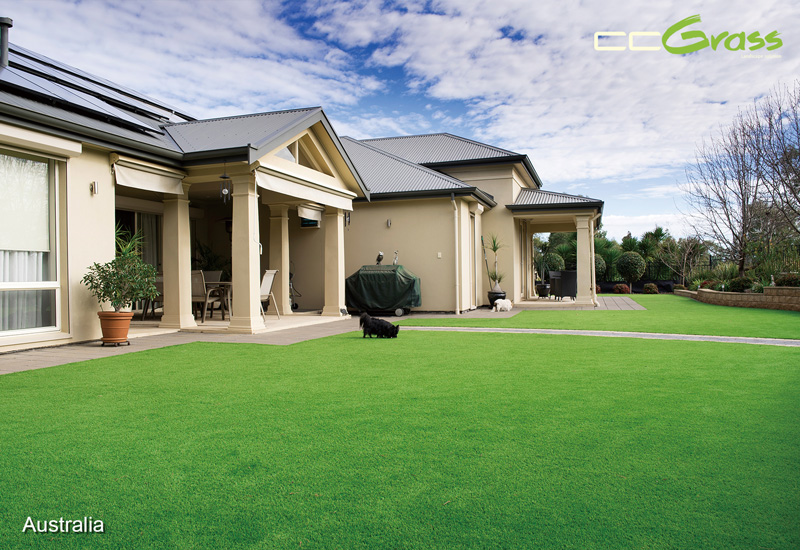
27. In the elegant backyard, a blue sky and white clouds complement a green lawn, crafting a tranquil outdoor space. The verdant artificial turf spans the area, offering both visual delight and an ideal space for pets to frolic freely.
Small Backyard Oasis – Maximizing Coziness
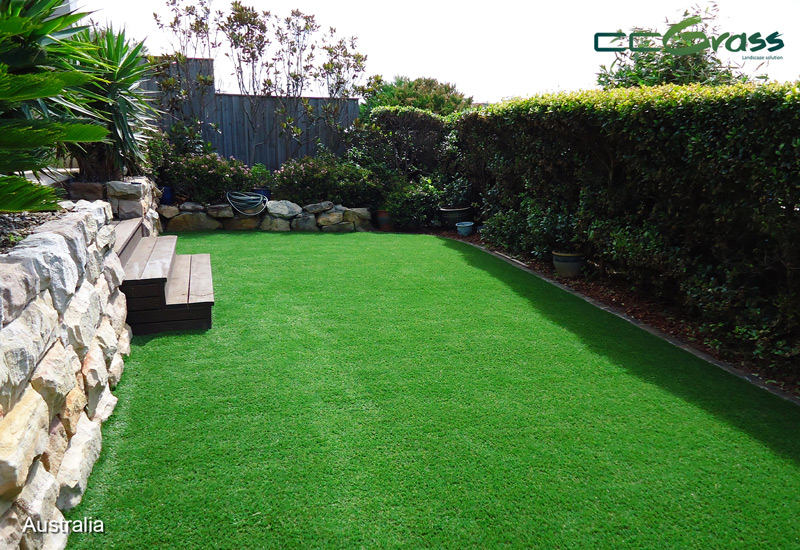
28. Opt for fake grass in small backyards for easy and cost-effective landscaping. It eliminates the need for lawnmowers and trimmers, offering a hassle-free, tidy mini oasis.
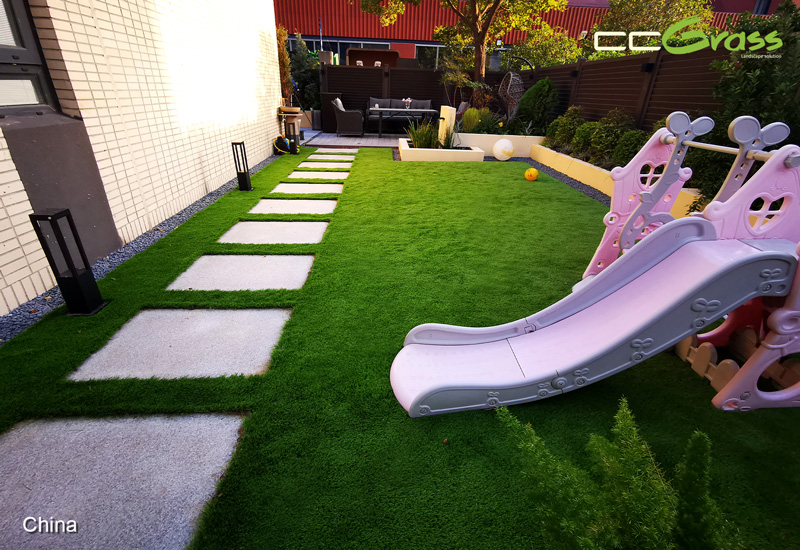
29. This synthetic grass stepping stones combo is very popular. What was once a simple rectangular space now boasts a modern and versatile environment.
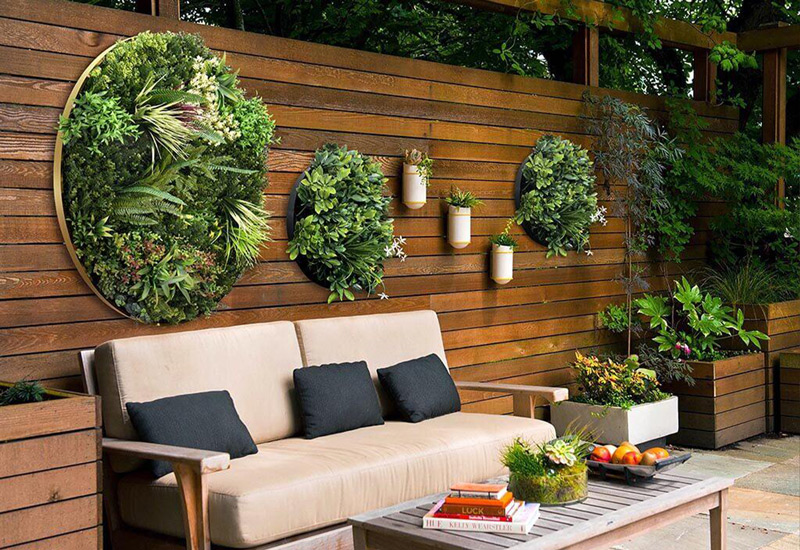
30. Optimize vertical space with artificial vertical gardens for a touch of nature without sacrificing square footage—an ideal solution for small backyards.
Find More Backyard Turf Ideas
Discover more artificial grass backyard landscaping ideas and designs at CCGrass Landscape!
With a diverse range of residential artificial turf options at competitive prices, CCGrass serves wholesalers, retailers, contractors, DIY/retail chains, and more. Call us at 86 25 6981 1666 or email us at [email protected] to ask for free samples now!
Golf is a challenging but rewarding sport that requires a lot of practice and patience. More and more golfers choose artificial grass putting greens because they are easy to install and maintain, perform well and look attractive. So how do you create a satisfactory artificial putting green?
With this guide, you will learn how to choose the best artificial putting green turf as well as the knowledge of installing and maintaining the putting green, let us take a look.
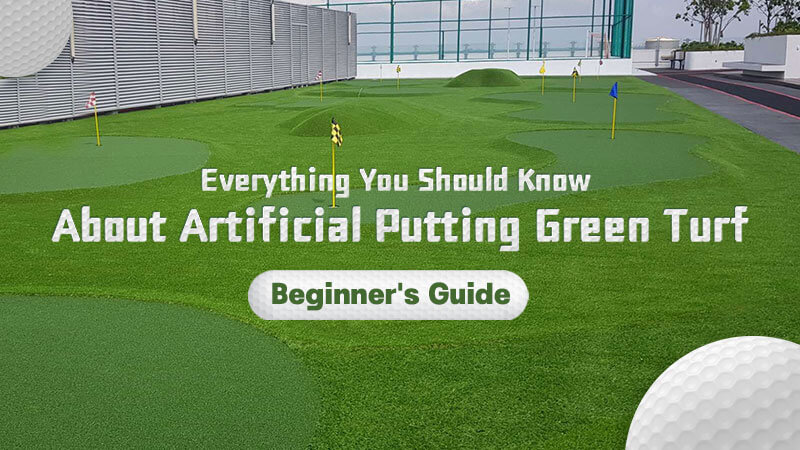
In this article:
- How to choose artificial grass for putting green?
- Why you should use artificial putting green turf?
- Recommendations for the best artificial putting green turf
- How to install artificial putting green turf in the backyard?
- How to clean and maintain artificial grass when putting green?
- Fake grass putting green FAQs
- Q: Why choose a fake grass putting green over natural grass?
- Q: DIY or hire a pro to install a fake grass putting green?
- Q: How do you adjust the stimp speed of an artificial putting green?
- Q: How long does an artificial turf putting green last?
- Q: Will practising on a fake grass putting green improve my golf skills?
- Conclusion
How to choose artificial grass for putting green?
Common materials of artificial putting green turf
Artificial putting green turf is a low-pile fake grass that allows golf balls to roll. It is made of durable synthetic fiber materials such as nylon, PE or PP.
Among these materials, nylon is renowned for its durability, resulting in a longer lifespan but at a higher cost. Recently, PE curly monofilament fibers have been trending, providing a compact and smooth surface for optimal ball interaction.
Pile height of putting green turf
The length of the tufts measured from the primary backing top surface to their tips, is usually measured in millimeters (mm). High-pile artificial grass is good for trendy yards as it is more comfortable and lush, but putting greens should have a lower pile height to ensure true ball rolling. The pile height of most putting green surfaces ranges from 13mm to 18mm.
Face weight of putting green turf
Choose thick, high-density artificial grass for your golf putting green, depending on the face weight of the turf. Higher face weight means denser and more durable grass products. Artificial putting green turf with a face weight between 50 and 70 ounces per square yard is ideal.
Turf backing and drainage
The turf backing plays a crucial role in securing the tufted fibers in place, ensuring the desired ‘tuft lock’. CCGrass provides various backing options such as latex, PU, PRT, or RCX. Testing reveals that PU backing, in particular, enhances surface smoothness, offering users a more seamless experience.
While drainage may not be a major concern for the relatively small area of a putting green, PU backing ensures effective drainage, maintaining the playability of the surface.
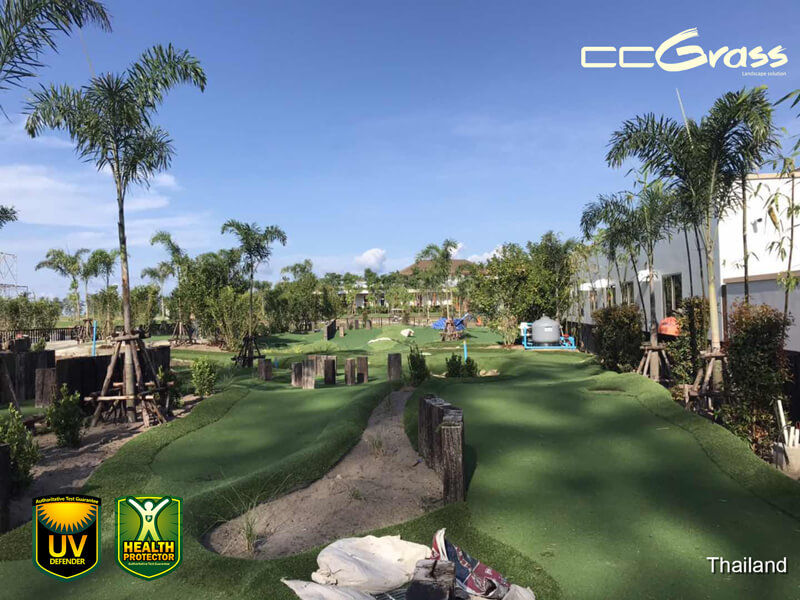
UV protection
Outdoor putting green turf is always exposed under the burning sunbeam. Good UV resistance can keep the grass yarn colorfast for years, thus prolonging the life of the putting green. CCGrass artificial grass uses the best UV inhibitors, tested by SGS to UVA 5000h and UVB 3000h, exceeding industry standards.
Putting green infill
The type and amount of infill affects ball speed, ball bounce, and more. One of the most commonly used infills is silica sand, which helps keep the fibers upright and enhances the appearance and performance of the putting green. Infill also regulates the speed of the green, you can add more infill to increase the ball speed or remove infill to make the ball roll more slowly.
For surfaces that require no infill, consider those made from polyethene curly fibers. These fibers stand upright on their own, creating a dense and smooth surface that maintains its shape without the need for infill, providing immediate usability and convenience.
Recreational putting greens vs. professional putting greens
The stamp rating and chipping distance differ between recreational and professional putting greens. The stamp rating indicates the speed of the ball on the putting green while chipping distance refers to the short distance covered when hitting the ball onto the green. Notably, both stimp rating and chipping distance are considerably greater on professional putting greens compared to recreational ones.
Professional putting greens cost 20-50% more due to intricate design needs like specific green slopes and higher standards in turf management. They aim for a heightened challenge and must meet strict competition specifications. In contrast, recreational greens prioritize entertainment and easy maintenance.
You can choose recreational or professional artificial grass putting green according to your usage intention and budget.
Why you should use artificial putting green turf?

Save time & money
No mowing, no watering, no spraying, no fertilizing, which is environmentally friendly and saves the expensive and time-consuming maintenance, so you could spend more time enjoying the green with your family and hone your golf skills.
Unmatched putting green experience
Our state-of-the-art artificial putting green turf is designed and manufactured from a real putting green experience, offering unparalleled realism in appearance and performance, helping all golfers achieve the perfect shot every time.
Wide range of applications
Synthetic green turf can be installed in virtually any location, regardless of the size of your area. It is versatile and well-suited for a variety of purposes, including indoor and outdoor greens, mini golf, golf courses, commercial settings, training centres, and more.
Great golf training
Create an artificial grass putting green at home so you can train on fresh, natural-looking and comfortable grass surface year-round. Don’t need to go to golf course every time, perfect for professional golfers or beginners to practice their golf swing.
Recommendations for the best artificial putting green turf
FastPro – Best backyard putting green turf
Our putting green turf FastPro series is excellent for both professional and amateur golfer to practice their putting techniques. It features the latest technology texturised monofilaments with dense stitches for a true and consistent golf ball roll on the surface.
Highlights
- 100% PE curly monofilament
- Professional sports products
- Extreme UV stability and durability
- Smooth surface for great playability
Portable golf putting mat – Perfect for home or office
The realistic synthetic grass mat can be rolled out indoors or out, so you can practice your putts almost anywhere. Our golf putting mat is versatile for home practising, backyard sporting, family entertainment, and office relaxing.
Highlights
- 100% PE curly monofilament
- Realistic golf course experience
- Long-lasting smoothness
- Customize with style, color, and size options
Stemgrass EX2 for putting green fringe
The Fastpro putting green surface is best optimized when combined with Stemgrass EX2 fringe. The putting green fringe not only helps keep the ball on the green, but also provides stability and protection for the putting green.
Highlights
- Super wear resistance
- Good standing ability
- More natural foot feel
- FIFA certified product
How to install artificial putting green turf in the backyard?
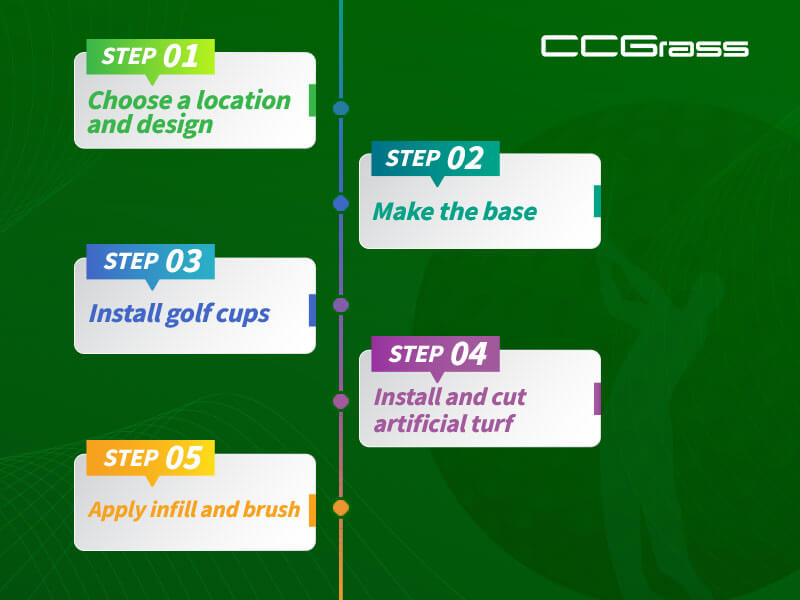
Step1: Choose a location and design
It’s up to you to decide where to place the putting green first. Look for a horizontal location with good drainage. Then communicate with the professional company, inquire, design and order the putting green turf.
Step2: Make the base
The installer will outline the yard with spray paint according to the blueprint. Excavate 3-5 inches of native soil inside the outline, levelling and laying down an optional weed barrier on top of the excavated area.
Then put crushed stone into the area and spread out evenly, compacting with a compacting machine to create a smooth, flat base.
Step3: Install golf cups
Another critical step in installing a backyard putting green is deciding where the cups go. Use a shovel or spatula to make holes for the cups and insert golf cups into the holes. To ensure reliable installation, it is recommended to apply concrete to secure the rim of the cup. Then, compact the sub-base around each cup with a hand compactor to level the surface.
Step4: Install and cut artificial turf
Place green turf on the base and carefully cut out the shape and size of your design with a carpet knife. You can use chalk to scribe your design onto the top of the turf. As a rule of thumb, use turf nails along the perimeter to secure the contour. Next, use your hand to press down on the lawn to find the cups and use a carpet knife to cut out the holes.
Tip: Lay the turf flat in the sun for a few hours to allow it to stretch – this will remove creases and the fibers will be in better condition.
Step5: Apply infill and brush
Applying a proper layer of sand infill to your artificial putting green is very important. Use a stiff brush or electric broom to vertically brush synthetic grass to make sure the infill is evenly spread out.
How to clean and maintain artificial grass when putting green?
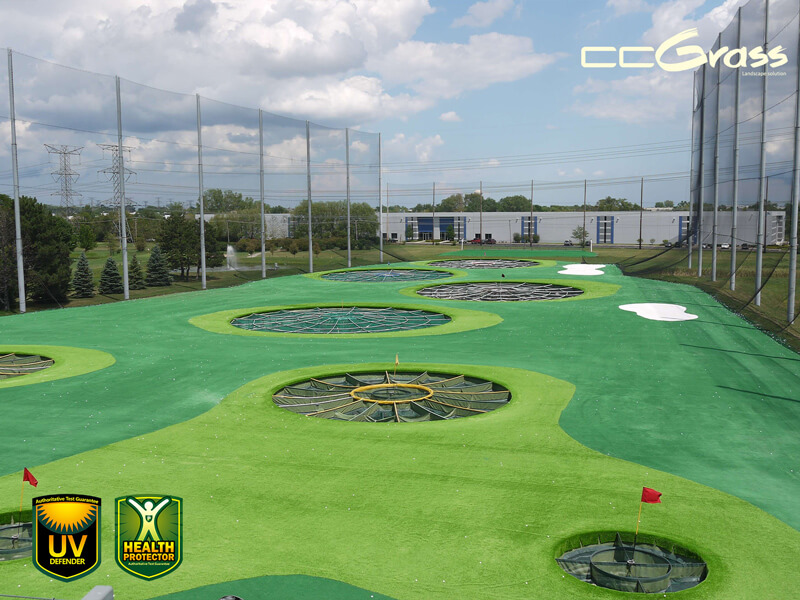
Artificial putting greens require some simple maintenance to keep them in top condition.
- Weekly: Remove debris such as leaves from putting green turf.
- Monthly: If your putting green gets dusty, you can simply rinse your grass with a water hose. For mildly soiled areas, a basic mixture of warm water and a small amount of mild household detergent solution will do the trick! Just wipe it with a sponge and then rinse.
- If the blades look flat: Rake the turf so that the blades stand up.
- Avoid wearing high heels or carrying sharp objects onto the putting green area.
- Keep sticky objects such as chewing gum away from your putting green turf.
Fake grass putting green FAQs
Q: Why choose a fake grass putting green over natural grass?
Here’s a quick comparison between artificial grass and natural grass putting greens:
| Aspect | Fake grass putting green | Natural grass putting green |
| Maintenance | Low (no mowing, no watering, no fertilizing) | High (regular mowing, watering, fertilizing) |
| Environmental Impact | Minimal (no chemicals, less water usage) | Requires pesticides, water, and chemicals |
| Year-round Playability | Yes | Seasonal limitations |
| Durability | High (resistant to wear and tear) | Subject to wear from foot traffic and weather conditions |
| Safety | Safer (non-toxic, minimal risk of allergies); non-slip surface | Potential allergies; slippery when wet |
| Cost | Economical long-term investment; pay once and enjoy savings | Annual lawn expenses (equipment, maintenance, watering) |
Q: DIY or hire a pro to install a fake grass putting green?
Installing artificial putting greens requires precision for a smooth and level playing surface. Due to the complexity, DIY installation is generally discouraged. Opt for professional assistance to ensure a long-lasting backyard putting green of the highest quality.
For those seeking a convenient solution, our Golf Putting Mat, with its lightweight and easily storable features, requires no installation. It is exceptionally versatile, suitable for both indoor and outdoor use, making it an ideal choice for golfers of all ages.
Q: How do you adjust the stimp speed of an artificial putting green?
The stimp speed of an artificial putting green is fine-tuned by adjusting silica sand infill – more infill for a faster roll, less for a slower pace. Choosing specific grass materials, like compressed poly or thin-bladed nylon, creates a harder and more compact surface, resulting in faster ball roll.
Q: How long does an artificial turf putting green last?
The longevity of an artificial turf putting green is influenced by factors including material quality, usage, regular maintenance, and exposure to climate and sunlight. With proper care, high-quality putting green turf can endure for up to 10 years or more, providing long-lasting enjoyment for golf enthusiasts.
Q: Will practising on a fake grass putting green improve my golf skills?
Certainly! Training on a synthetic turf putting green significantly enhances golf skills. The consistent surface aids precision and muscle memory, while the convenience of a home green allows for frequent practice, thereby boosting confidence. Many pros swear by artificial turf greens for honing short-game skills.
Conclusion
The emergence of artificial grass-putting greens has broken the tradition that only when you go to the golf course can you enjoy the fun of swinging, making the dream of playing golf anytime and anywhere a reality.
Armed with a thorough knowledge of the artificial putting green turf, it’s time to build your own putting paradise and start swinging!


